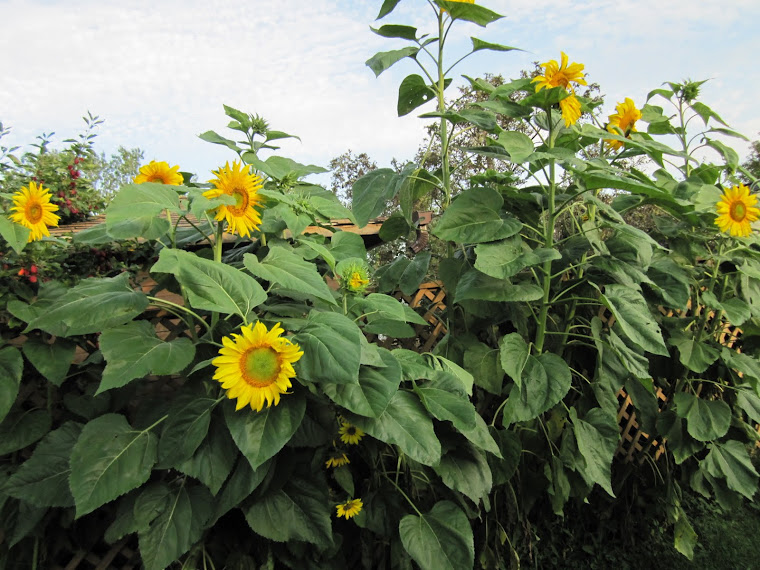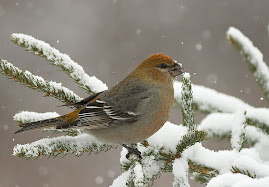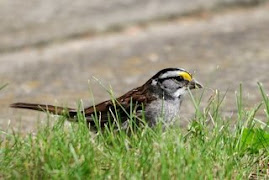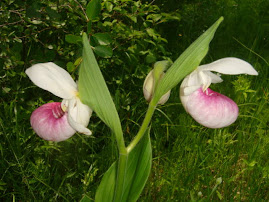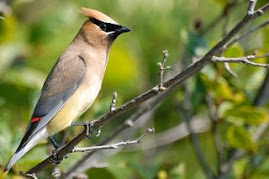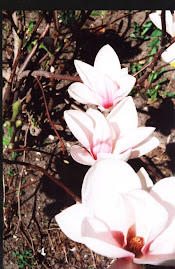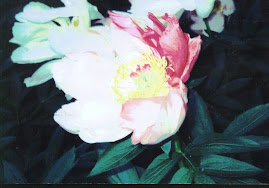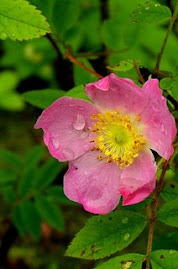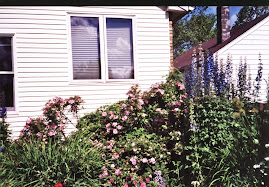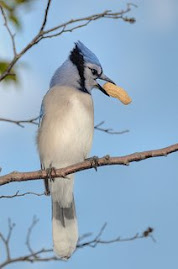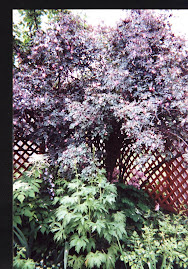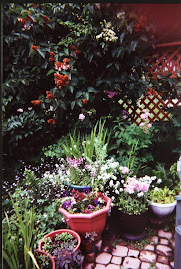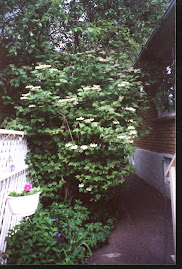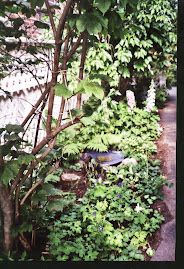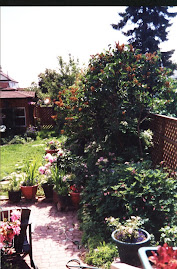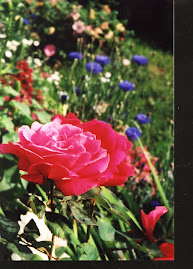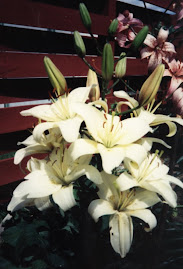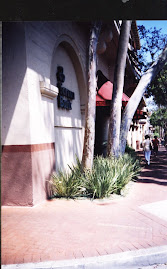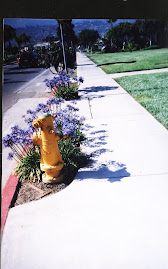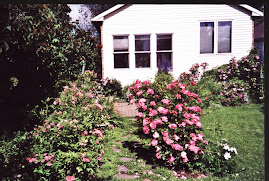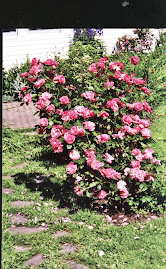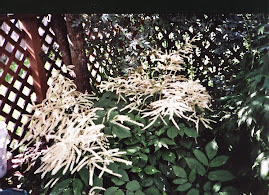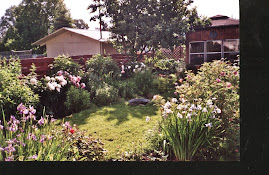Canadian Gardening has an interesting gift list in the current issue. My fav is the following: "My dream gift for Christmas would be a young, strapping male with meaty thighs and a willingness to fulfil my every desire—but mostly to dig, dig, dig.""
Otherwise, consider the following.
1) A garden bandit or weed looper. Just a pole with a loop of metal on the end but oh, what a back saver and efficient weeder.
2) A kneeling stool which can also be turned over to use as a seat. This item is a knee saver and you will find plenty of other uses for it.
3) A pair of Felcro pruners, the best made.
4)A lovely indoor plant or selection of indoor herbs
5) A beautiful bird feeder.
Tip. If you are prone to achy lower back muscles , try this wonderful tip. When you feel the ache coming on, just stand and give yourself a good shake. Shake you fanny and your entire body. Magic.
Tuesday, 9 December 2008
Friday, 21 November 2008
Tand T Comes Through
Just when the garden is sinking into winter and looking a bit bleak, along comes the first seed catalogue. TandT, a reliable Manitoba grower, first off the mark.
I get several catalogues and I have ordered from many but in the last few years I found all the seeds I need in Stokes and T&T. Stokes is so detailed and gives such good growing information that it is a must for anyone starting seeds inside. T&T provides the Manitoba favourites and if it grows in Winnipeg, it can grow here.
Most seed catalogues start with new introductions. For instance this year T&T offers a frilly petunia, a white egg plant, a striped morning glory and so on. I pay little attention to this section. These plants are for those gardeners who are interested in novelty. Many of these newcomers are never seen in subsequent editions of the catalogue and one wonders just how successful they were for the average home grower.
I seldom order plants from catalogues. I prefer to use the local nurseries and see the plant before I buy.
So what do I look for? Every garden is in flux; every garden changes from year to year. Each year I see new ideas, seeds to try for new conditions. Next year I want more sweet peas, more sunflowers and shorter lilies for border. I'd like to try ferns in the increasing shade of the side garden. I want to switch to a different variety of squash. In the past I grew Swiss chard and I'd like to grow it again. I have increased the size of the front garden bed and have no idea what to put in it yet.
And above all, I love looking at the pictures and dreaming of another season.
Tip. The loop weeder is the greatest garden tool for saving your back. It is just a loop of metal at the end of a long pole. No more bending, kneeling and hand digging weeds. Just swipe into the soil, chomp the weed and leave it where it lies. It is much more efficient and easy than a hoe. A great gift for elderly gardners.
I get several catalogues and I have ordered from many but in the last few years I found all the seeds I need in Stokes and T&T. Stokes is so detailed and gives such good growing information that it is a must for anyone starting seeds inside. T&T provides the Manitoba favourites and if it grows in Winnipeg, it can grow here.
Most seed catalogues start with new introductions. For instance this year T&T offers a frilly petunia, a white egg plant, a striped morning glory and so on. I pay little attention to this section. These plants are for those gardeners who are interested in novelty. Many of these newcomers are never seen in subsequent editions of the catalogue and one wonders just how successful they were for the average home grower.
I seldom order plants from catalogues. I prefer to use the local nurseries and see the plant before I buy.
So what do I look for? Every garden is in flux; every garden changes from year to year. Each year I see new ideas, seeds to try for new conditions. Next year I want more sweet peas, more sunflowers and shorter lilies for border. I'd like to try ferns in the increasing shade of the side garden. I want to switch to a different variety of squash. In the past I grew Swiss chard and I'd like to grow it again. I have increased the size of the front garden bed and have no idea what to put in it yet.
And above all, I love looking at the pictures and dreaming of another season.
Tip. The loop weeder is the greatest garden tool for saving your back. It is just a loop of metal at the end of a long pole. No more bending, kneeling and hand digging weeds. Just swipe into the soil, chomp the weed and leave it where it lies. It is much more efficient and easy than a hoe. A great gift for elderly gardners.
Wednesday, 19 November 2008
Cue the snow, cue the storm, cue the howling winds
Now that our gardens are slipping under the snow, it is a good time to take stock of the past year.
I congratulate myself on reaching November without a garden injury this year -no bursitis, no bad back, no pulled muscles. In the past, I have not been so lucky.
This year I was determined to limit my garden tasks and only work at each for no more than twenty minutes. Easy to say but when you work in a garden, time changes its character. It falls away and loses all meaning. You are always in the present so time does not move along at a normal pace. And there is always is the temptation to do a little bit more.
But this year I bought a garden clock, an item I believe is a necessity to preserve the health of gardeners. I limited myself to twenty minutes per task and the clock, way up on the wall of the garden shed, monitored the minutes. I suppose a kitchen timer would work just as well.
Dr. Charles Bryan, a local chiropractor, who has seen a fair number of gardeners' aching backs and repetitive strain injurues, says the first rule of gardening is to put a limit on each task. Gardening is an athletic endevour he says and just as most of us cannot run for hours so we cannot garden for hours.
Garden clocks or exterior clocks showed up in garden centres two years ago. At first they were expensive but the price dropped this year. My clock is made of scrolly iron work and takes two A batteries. I think it is an attractive garden feature.
I congratulate myself on reaching November without a garden injury this year -no bursitis, no bad back, no pulled muscles. In the past, I have not been so lucky.
This year I was determined to limit my garden tasks and only work at each for no more than twenty minutes. Easy to say but when you work in a garden, time changes its character. It falls away and loses all meaning. You are always in the present so time does not move along at a normal pace. And there is always is the temptation to do a little bit more.
But this year I bought a garden clock, an item I believe is a necessity to preserve the health of gardeners. I limited myself to twenty minutes per task and the clock, way up on the wall of the garden shed, monitored the minutes. I suppose a kitchen timer would work just as well.
Dr. Charles Bryan, a local chiropractor, who has seen a fair number of gardeners' aching backs and repetitive strain injurues, says the first rule of gardening is to put a limit on each task. Gardening is an athletic endevour he says and just as most of us cannot run for hours so we cannot garden for hours.
Garden clocks or exterior clocks showed up in garden centres two years ago. At first they were expensive but the price dropped this year. My clock is made of scrolly iron work and takes two A batteries. I think it is an attractive garden feature.
Sunday, 16 November 2008
The snowless area
Snow to the east and snow to the west but nothing to speak of in Thunder Bay. Deep grey clouds sail over but no drama. A friend, a long time resident, says she can smell approching snow but she does not smell it yet. She says there is a hush, as if the trees were holding their breath, but she has not tuned into this either.
I make a trip out to Vanderweese to look at the wonderful Christmas displays. I am also hoping to find dwarf ameryllis but no luck. I note their bulbs run from 13$ up, at least five dollars more expensive for similar bulbs in the supermarket.
At home I put out water for the birds and every day I thaw ice in the big plastic plant saucer with a kettle of hot water. The birds are on the hunt for water these days as the usual supplu slowly freezes over. Several years ago I bought a bird bath heater but it did not work well in deep cold. I will use the kettle method until the big freeze sets in.
A downy woodpecker, which I have seen in this urban neighbourhood before, shows up for some suet cake. She is a female, as shown by the lack of the red spot on the back of the head. The downy is the most common woodpecker found in the city. This small upright black and white bird sometimes gives a high squeaking call.
A gang of starlings are eating the crab apples. Darn! I was hoping to attract cedar waxwings but no, the short tailed speckled guys with their long bills are stripping the fruit now that the frost has softened it.
On the patio, the juncos look like sparrows dressed in tuxedos. They are black with a white tummy and when they fly you can see their natty white outer tail feathers. Sometimes they give a funny little hop. They also make clicking noises, probably to keep in touch with each other.
I make a trip out to Vanderweese to look at the wonderful Christmas displays. I am also hoping to find dwarf ameryllis but no luck. I note their bulbs run from 13$ up, at least five dollars more expensive for similar bulbs in the supermarket.
At home I put out water for the birds and every day I thaw ice in the big plastic plant saucer with a kettle of hot water. The birds are on the hunt for water these days as the usual supplu slowly freezes over. Several years ago I bought a bird bath heater but it did not work well in deep cold. I will use the kettle method until the big freeze sets in.
A downy woodpecker, which I have seen in this urban neighbourhood before, shows up for some suet cake. She is a female, as shown by the lack of the red spot on the back of the head. The downy is the most common woodpecker found in the city. This small upright black and white bird sometimes gives a high squeaking call.
A gang of starlings are eating the crab apples. Darn! I was hoping to attract cedar waxwings but no, the short tailed speckled guys with their long bills are stripping the fruit now that the frost has softened it.
On the patio, the juncos look like sparrows dressed in tuxedos. They are black with a white tummy and when they fly you can see their natty white outer tail feathers. Sometimes they give a funny little hop. They also make clicking noises, probably to keep in touch with each other.
Sunday, 9 November 2008
snow, lovely snow
A light snow is sifting down. The juncos leave birdy tracks on the patio where they are feasting on black oil sunflower seeds. The resident chickadee pecks at the bird cake in its holder. The grey squirrel arrives to steal what it can.
The garden is settling into winter. The gardener is still washing pots inside. She had a pleasant gift this week, ten big plastic bags full of leaves. She drags them to the compost and empties several over the remaining pile and turns out one bag over the daphne bush, a tender plant still holding on to its variegated leaves.
But in the back garden all leaves are fallen. Only a few berries remain on the high bush cranberry and nothing on the mountain ash. The lamium, alive yesterday, is frozen today. In front, the mullein still blooms in the sharp wind and blowing snow. It must be the world's toughest plant. It has been blooming since August.
I should have brought the hose in earlier, thinks the gardener, struggling with a frozen 100 feet of ice.
Now is the time to plant the indoor bulbs. The amarylis have arrived at Vanderweese and other stores. Nothing is more cheery in the winter than this marvelous indoor flower. Every child in Thunder Bay should have an amarylis to plant and watch it stretch into bloom.
The garden is settling into winter. The gardener is still washing pots inside. She had a pleasant gift this week, ten big plastic bags full of leaves. She drags them to the compost and empties several over the remaining pile and turns out one bag over the daphne bush, a tender plant still holding on to its variegated leaves.
But in the back garden all leaves are fallen. Only a few berries remain on the high bush cranberry and nothing on the mountain ash. The lamium, alive yesterday, is frozen today. In front, the mullein still blooms in the sharp wind and blowing snow. It must be the world's toughest plant. It has been blooming since August.
I should have brought the hose in earlier, thinks the gardener, struggling with a frozen 100 feet of ice.
Now is the time to plant the indoor bulbs. The amarylis have arrived at Vanderweese and other stores. Nothing is more cheery in the winter than this marvelous indoor flower. Every child in Thunder Bay should have an amarylis to plant and watch it stretch into bloom.
Monday, 3 November 2008
High Park Toronto
Some years ago, the decision was made to change Toronto's High Park from a typical urban manicured space into an ecological wilderness. What a delight it is. From downtown you take the Queen Street East street car to Park Drive. You can walk the trails around Grenedier Pond and up to the restaurant where you can get a nice hot chocolate. Native trees and plants attract plenty of birds: ducks, trumpeter swams, cormorants, Canada geese on the ponds and gold finches, sparrows and late warblers in the trees. There is also a small zoo hidden in there somewhere. Thunder Bay has few oak trees but here there are many. In October they are a deep copper colour, beautiful alongside the bright red maples.
Even in late October Toronto gardens are interesting. A few roses bloom on. Many small downtown front yards have eschewed lawn for rock/plant/shrub compositions. I saw plenty of lamium and lots of spreading allysum.
Even in late October Toronto gardens are interesting. A few roses bloom on. Many small downtown front yards have eschewed lawn for rock/plant/shrub compositions. I saw plenty of lamium and lots of spreading allysum.
Friday, 24 October 2008
Oh Natural!
From the corner of Balmoral and Central Avenue, turn west past Robins's and the car wash place. A little farther along, on the right side is the Central Natural Enviromental Garden, a nice place to stop and walk about or sit for a while. A picnic table provides one of the few places to eat a picnic in the inter-city area. There is a small parking area at the back.
A set of wild flower gardens unfurl under the willows, spruces, pines and two lovely small gold tamaracks. Even in the late fall, there is lots of interest as the natural plants hold out their seeds and the birds arrive.
Evening primrose, prairie sunflower, pearly everlasting, golden rod, dame's rocket, brown eyed susan, anise hysop, mullein, hawk weed (also called devil's paint brush), pinks, flax and other wild flowers are identified by well-made signs. This is a good place to check out the looks of the wild plants that you might want to use in your own garden.
I was interested to see a pile of wood chips at the back of the garden and note the use of wood chips between the groups of plants. Wood chips make a great weed repelling mulch, much more attractive and enviromentally friendly than plastic or weed barrier cloth. Also I some of the paths are just made of mown grass, a very nice way to create a path in a heavily planted garden.
A set of wild flower gardens unfurl under the willows, spruces, pines and two lovely small gold tamaracks. Even in the late fall, there is lots of interest as the natural plants hold out their seeds and the birds arrive.
Evening primrose, prairie sunflower, pearly everlasting, golden rod, dame's rocket, brown eyed susan, anise hysop, mullein, hawk weed (also called devil's paint brush), pinks, flax and other wild flowers are identified by well-made signs. This is a good place to check out the looks of the wild plants that you might want to use in your own garden.
I was interested to see a pile of wood chips at the back of the garden and note the use of wood chips between the groups of plants. Wood chips make a great weed repelling mulch, much more attractive and enviromentally friendly than plastic or weed barrier cloth. Also I some of the paths are just made of mown grass, a very nice way to create a path in a heavily planted garden.
Thursday, 23 October 2008
Garden, stil going on.
I cannot believe things are still blooming in the gardens around town. Today I was amazed to see a Stella d'oro day lily arrive with a few fat buds ready for the next few days. Stella is not my favourite day lily. It is not very florifierous and it is small. But if I ever fulfil my dream to make a garden room entirely of day lilies and Asiatic lilies, Stella would be there if only because it is tough.
The marigolds are amazing around town. My tiny yellow ones, (a variety called lemon gem grown from seeds fromT&T) may bloom all winter. They pay no intention to the frost at night. I gave away a lot of lemon gem plants which are blooming merrily where ever they were planted. They make balls of small yellow flowers and, in fact, do not look like marigolds at all.
Also hanging around are the bachelor buttons and a few Marie Bugnet roses. Don't these plants know it is almost Hallowe'en?
Is it my imagination or are the leaves also slow to fall this year. I am ready for them. I rake them into a tarp, gather up the corners and toss them on the compost. I also like to get a few clear plastic bags full of leaves to put on the compost as a sort of insulation. They rot a bit inside the plastic. In spring I use them to layer up with greener compost material.
I will spread compost over the garden now. I know that the garden magazines say to spread it in the spring, but these magazines are written in wussy Southern Ontario, a place where you can put a garden fork into a compost pile in April. We are lucky if we can clean out a compost pile in June without hitting ice. So I spread the good stuff at the bottom of the pile now and replace all the half rotten stuff for another year.
The marigolds are amazing around town. My tiny yellow ones, (a variety called lemon gem grown from seeds fromT&T) may bloom all winter. They pay no intention to the frost at night. I gave away a lot of lemon gem plants which are blooming merrily where ever they were planted. They make balls of small yellow flowers and, in fact, do not look like marigolds at all.
Also hanging around are the bachelor buttons and a few Marie Bugnet roses. Don't these plants know it is almost Hallowe'en?
Is it my imagination or are the leaves also slow to fall this year. I am ready for them. I rake them into a tarp, gather up the corners and toss them on the compost. I also like to get a few clear plastic bags full of leaves to put on the compost as a sort of insulation. They rot a bit inside the plastic. In spring I use them to layer up with greener compost material.
I will spread compost over the garden now. I know that the garden magazines say to spread it in the spring, but these magazines are written in wussy Southern Ontario, a place where you can put a garden fork into a compost pile in April. We are lucky if we can clean out a compost pile in June without hitting ice. So I spread the good stuff at the bottom of the pile now and replace all the half rotten stuff for another year.
Wednesday, 15 October 2008
Bringing plants inside
What can thrive inside and what can't. Many herbs can make the transition to a sunny window. Some herbs such as the perennial, rosemary, do well indoors. The parsleys do fine but my basil falls apart. Maybe this Mediterranean herb does not get enough light as the days shorten.
Last year I brought pansy plants inside, sheared them back and hoped they would bloom again. They did do so but with such small short-lived blooms the experiment was hardly worth the effort. I remembering giving one pansy plant as a gift to be told later that blooms fell off and in a few days the plant died. Not a great gift.
This year I have brought in a few geraniums and they are starting to set buds already.
Ever since I had an infestation of aphids in the plants of my back porch, I have been very cautious about bringing in the outdoors. I was able to defeat the aphids with Safer's Trounce but recently I heard of a woman who brought in slugs (or the eggs) and they crawled around her basement. Yikes! Before I bring a plant inside for the winter, I pull it, shake off the excess soil and give it a quick bath in warm soapy water. (Soapy water kills aphids. ) I rinse it off under the hose and replant inside using a sterile soil mix such as Pro-mix. The plants survive this rough treatment surprisingly well.
Last year I brought pansy plants inside, sheared them back and hoped they would bloom again. They did do so but with such small short-lived blooms the experiment was hardly worth the effort. I remembering giving one pansy plant as a gift to be told later that blooms fell off and in a few days the plant died. Not a great gift.
This year I have brought in a few geraniums and they are starting to set buds already.
Ever since I had an infestation of aphids in the plants of my back porch, I have been very cautious about bringing in the outdoors. I was able to defeat the aphids with Safer's Trounce but recently I heard of a woman who brought in slugs (or the eggs) and they crawled around her basement. Yikes! Before I bring a plant inside for the winter, I pull it, shake off the excess soil and give it a quick bath in warm soapy water. (Soapy water kills aphids. ) I rinse it off under the hose and replant inside using a sterile soil mix such as Pro-mix. The plants survive this rough treatment surprisingly well.
Monday, 13 October 2008
Last Tea in the Garden?
It takes five minutes for the garden to arrive. When you are out there with your cup of tea or your lunch, your mind, for the first five minutes, continues to huffle along with its indoor thoughts: tasks to do, the upcoming elections, the book you are reading, the state of your life generally. But at the same time you are looking around and the garden world is permeating your brain and then it "arrives" and you feel yourself part of your outdoor place. You notice everything within view and the greenery becomes part of you.
I love variegated leaves on plants and in the fall the entire garden is variegated. There are many gold leaves among the green. The hostas glow golden as do have the leaves of many bushes. A few red leaves show on the high bush cranberry and the peonies. Tiny dots of blue mark the last bachelor buttons. A lone pink cosmos shines against the fence. The spikes of monks hood and delphiniums are brown. But the main colour now is green, dark green grass mixed with autumn leaves.
I love variegated leaves on plants and in the fall the entire garden is variegated. There are many gold leaves among the green. The hostas glow golden as do have the leaves of many bushes. A few red leaves show on the high bush cranberry and the peonies. Tiny dots of blue mark the last bachelor buttons. A lone pink cosmos shines against the fence. The spikes of monks hood and delphiniums are brown. But the main colour now is green, dark green grass mixed with autumn leaves.
Sunday, 12 October 2008
A Bird in the Hand
I once saw a chickadee eating from a baseball glove. The glove was on the hand of a friend. She had set up a sort of stick man and fed the birds from the glove attached to an arm stick. Later she held the glove and the chickadees gradually came.
Another friend tells me how he enticed the whiskey jacks. He put dog food on a small table outside. As many dog owners in the country are aware, whiskey jacks love pet food. My friend sat on a chair at some distance from the table. Gadually he moved the chair closer. Finally he was sitting at the table. Everything good comes in small steps. An arm on the table. An arm with an open hand with food in it. They hop right up. Now when he walks around his country property, he has to load his pockets with dog food.
The sad news is that few of us in town are lucky enough to have whiskey jacks come to our feeders. The good news is that the juncos, those weed seeding eating fiends, have arrived.
Another friend tells me how he enticed the whiskey jacks. He put dog food on a small table outside. As many dog owners in the country are aware, whiskey jacks love pet food. My friend sat on a chair at some distance from the table. Gadually he moved the chair closer. Finally he was sitting at the table. Everything good comes in small steps. An arm on the table. An arm with an open hand with food in it. They hop right up. Now when he walks around his country property, he has to load his pockets with dog food.
The sad news is that few of us in town are lucky enough to have whiskey jacks come to our feeders. The good news is that the juncos, those weed seeding eating fiends, have arrived.
Thursday, 9 October 2008
Trees and Landscaping
The south end of Syndicate Avenue looks lovely with its new pavement patterns and healthy small trees. Other places around town, particularly the down town areas and the west end of Bay Street are enhanced by small trees which one day, and not far off, will produce inviting streetscapes. Of course, once you move away from the business streets and into the residential areas, you find shady walks, lovely gardens, interesting landscaping.
But alas it is not enough. Our city planners and local businesses have busied themselves this summer dumping tar everywhere. Not on drive or walkways where asphalt is needed but any other place possible. On earth spaces where bushes, plantings and small trees could go, we in Thunder Bay get more black tar. It stretches along side sidewalks, on road medians and corners, around businesses and apartment buildings with, often, a dumpster or a pile of tires to complete the landscaping creating an instant slum look on our major streets.
Anything, anything, any monstrosity it better than planting something or pulling a weed. It seems odd to me that business staff can be asked to sweep a parking lot or pick up trash but cannot be required to remove a weed or water a planter.
I know that many of our local business owners would never consider paving their front lawns at home and adding a rusty fence or a dumpster or a garbage can or several large pot holes or a dilapidated sign. They would no more consider it than they would stand on their heads naked on their own roof tops. But the same owners turn their business into a slum and ruin our city. The idea that Thunder Bay will attract tourists is laughable after you take one drive along Memorial Avenue.
But alas it is not enough. Our city planners and local businesses have busied themselves this summer dumping tar everywhere. Not on drive or walkways where asphalt is needed but any other place possible. On earth spaces where bushes, plantings and small trees could go, we in Thunder Bay get more black tar. It stretches along side sidewalks, on road medians and corners, around businesses and apartment buildings with, often, a dumpster or a pile of tires to complete the landscaping creating an instant slum look on our major streets.
Anything, anything, any monstrosity it better than planting something or pulling a weed. It seems odd to me that business staff can be asked to sweep a parking lot or pick up trash but cannot be required to remove a weed or water a planter.
I know that many of our local business owners would never consider paving their front lawns at home and adding a rusty fence or a dumpster or a garbage can or several large pot holes or a dilapidated sign. They would no more consider it than they would stand on their heads naked on their own roof tops. But the same owners turn their business into a slum and ruin our city. The idea that Thunder Bay will attract tourists is laughable after you take one drive along Memorial Avenue.
Monday, 6 October 2008
Half a Frost
Last Thursday night, after a family dinner, I said good-bye to the garden. I walked around in the dark zero degree air and said good-bye to the big hosas, the cosmos, the lavatera, and the nicotania. The next morning I saw a half frosted garden.
It was interesting to note what survived and what lived. The plants close to the fence and the shed fared better than those exposed in the centre bed. The front yard was not touched at all nor was the side garden between two houses. But an area in the back a slight bit lower that the main section was badly hit. Usually the hostas are most susceptible to frost but this year it was the cosmos.
Today I pulled out black cosmos. They were the biggest and toughest cosmos I have ever grown. Many plants were over 6 feet tall with stalks like small trees. I also continued weeding and emptying pots. I empty pots the easy way by pulling out the plants and then tipping the pot into the garden and spreading the soil among the perennials. This is easier than shovelling into a wheel barrow etc.
It was interesting to note what survived and what lived. The plants close to the fence and the shed fared better than those exposed in the centre bed. The front yard was not touched at all nor was the side garden between two houses. But an area in the back a slight bit lower that the main section was badly hit. Usually the hostas are most susceptible to frost but this year it was the cosmos.
Today I pulled out black cosmos. They were the biggest and toughest cosmos I have ever grown. Many plants were over 6 feet tall with stalks like small trees. I also continued weeding and emptying pots. I empty pots the easy way by pulling out the plants and then tipping the pot into the garden and spreading the soil among the perennials. This is easier than shovelling into a wheel barrow etc.
Monday, 29 September 2008
PUTTING THE GARDEN TO BED
Yesterday was a wonderful day to work in the garden. Every warm and sunny day is precious now. As I puttered about the white-throated sparrows sang their autumn song composed of a few faint whistles quite diferent from the spring song of I-love-Ca-na-da,Ca-na-da, Ca-na-da. The autumn song is a faint echo but like many Canadians the white throats will spend the winter in warmer places.
I cleaned pots and boxes and planted the Orienpet lilies deep in a spot near the patio. All summer they grew in a big planter box and produced large flower heads. But as pot plants they were not entirely successful. They leaned this way and that and the blooms were down facing so you could not really see them unless you were close enough to peek under the petals. I have to think what to put into the big cedar box next year.
I see the lavatera is about finished for the year but the tiny lemon gem marigolds bloom magnificantly on. The tall nicotania is really coming into its own now. A spindly plant all summer, it sprang into bloom about a month ago and still carries on. This old fashioned variety sports thin white trumpet shaped flowers. During the summer, I vowed never to plant it again but now I am rethinking.
In spite of he heavy rain of a few days ago, the compost in the black composter was dry. The lid keeps out rain and that does not encourage what we want - i.e. rot. The lid comes off for the season.
A friend in the country cut down her lovely apple tree. Every year it was attacked by a bear who left behind broken branches and no apples. In the city the apples attract the apple maggot fly and in the country, bears.
This year I bought grand apples at the farmers' market, my favourite Saturday destination. And I am not alone. The place is jammed at the opening bell at 8 a.m. I got another basket of blueberries, perhaps the last of an excellent season.
I cleaned pots and boxes and planted the Orienpet lilies deep in a spot near the patio. All summer they grew in a big planter box and produced large flower heads. But as pot plants they were not entirely successful. They leaned this way and that and the blooms were down facing so you could not really see them unless you were close enough to peek under the petals. I have to think what to put into the big cedar box next year.
I see the lavatera is about finished for the year but the tiny lemon gem marigolds bloom magnificantly on. The tall nicotania is really coming into its own now. A spindly plant all summer, it sprang into bloom about a month ago and still carries on. This old fashioned variety sports thin white trumpet shaped flowers. During the summer, I vowed never to plant it again but now I am rethinking.
In spite of he heavy rain of a few days ago, the compost in the black composter was dry. The lid keeps out rain and that does not encourage what we want - i.e. rot. The lid comes off for the season.
A friend in the country cut down her lovely apple tree. Every year it was attacked by a bear who left behind broken branches and no apples. In the city the apples attract the apple maggot fly and in the country, bears.
This year I bought grand apples at the farmers' market, my favourite Saturday destination. And I am not alone. The place is jammed at the opening bell at 8 a.m. I got another basket of blueberries, perhaps the last of an excellent season.
Labels:
bears,
composter,
nicotania,
white throated sparrows
Saturday, 27 September 2008
AUTUMN GARDEN
Becky Klein McCreary is a poet and gardener in the tiny town of Ouray, Colorado. Her poem expresses the sadness we feel when the garden disappears for the winter.
Autumn Garden
I am not ready
to put you away from chilling winds
into darkness
or slice into the stubby cuttings
for next year’s garden
or let trespassing deer
bite your tall, green crown
down to the brown soil
or stuff you into clay pots
that by mid-April
I have begun to dislike
Because you are too needy.
Lime green hostas
orphaned on our porch
grew plump this summer
in Box Elder’s shade
Thorny cactus, carefully cut
from ragged New Mexico ditches
lean out of terra-cotta pots.
Peppermint, lemon balm
chocolate mint, apple mint
garnished summer fruit bowls
and glasses of iced tea.
Oregano, thyme, and parsley
gathered into faded rag ribbons
drying for winter pasta dishes
cascading catnip, out of reach
sends kitty into a frenzy
while green-red hens and chicks
playfully tumble off the rocky roosts.
Feathery, copper fennel
waves in a wisp of wind
and daisies, coneflowers, yarrow
bow in their final performance.
I don’t want to put you away.
Autumn Garden
I am not ready
to put you away from chilling winds
into darkness
or slice into the stubby cuttings
for next year’s garden
or let trespassing deer
bite your tall, green crown
down to the brown soil
or stuff you into clay pots
that by mid-April
I have begun to dislike
Because you are too needy.
Lime green hostas
orphaned on our porch
grew plump this summer
in Box Elder’s shade
Thorny cactus, carefully cut
from ragged New Mexico ditches
lean out of terra-cotta pots.
Peppermint, lemon balm
chocolate mint, apple mint
garnished summer fruit bowls
and glasses of iced tea.
Oregano, thyme, and parsley
gathered into faded rag ribbons
drying for winter pasta dishes
cascading catnip, out of reach
sends kitty into a frenzy
while green-red hens and chicks
playfully tumble off the rocky roosts.
Feathery, copper fennel
waves in a wisp of wind
and daisies, coneflowers, yarrow
bow in their final performance.
I don’t want to put you away.
Thursday, 25 September 2008
Serendipity
As I was writing the post below about bulbs, a neighbour dropped by. He had been cleaning out a basement and had several dozen clay flower pots and plant saucers to give away. I was out of the house like a shot.
Many people do not like ceramic flower pots. When filled with soil and plants, they are heavy. The large ones are chiropractor's dreams. Clay pots cannot be left outside in our winter because you end up with clay shards. It is a chore to empty the large ones, lug inside, scrub them and store. Plastic is easier, cheaper and preferred nowadays.
However, the old fashioned clay pots have virtues. They are often more attractive than plastic, with fancy colours and embosssed designs. The terra cotta colour gives a traditional look to the garden. They are a better bet for indoor forcing. They retain moisture better than plastic and, more importantly, if the tulip or daffodil stretches, they do not tip.
I sanffled up a tall pot, perfect for amaryllis. These plants are notorious tippers as they stretch in the low light conditions of mid-winter. I also took four six-inch pots for my hyacinth bulbs and a squat pot with saucer to match, perfect for forcing crocus.
Four large plant saucers were a bonus. Two became bird baths, replacing the plastic saucers that have been chewed up by the weed whacker. Two will go under the palm tree and the fig in the porch, once I get around to repotting these monsters.
Tip. If the clay pot breaks or cracks, recycle. Throw it hard against something so it breaks, gather up the shards and use them for drainage when planting pots. I have a small shard collection in the basement to use when planting bulbs for forcing and a larger collection in the back shed for next spring. I also recycle any broken household dishes for drainage shards.
Many people do not like ceramic flower pots. When filled with soil and plants, they are heavy. The large ones are chiropractor's dreams. Clay pots cannot be left outside in our winter because you end up with clay shards. It is a chore to empty the large ones, lug inside, scrub them and store. Plastic is easier, cheaper and preferred nowadays.
However, the old fashioned clay pots have virtues. They are often more attractive than plastic, with fancy colours and embosssed designs. The terra cotta colour gives a traditional look to the garden. They are a better bet for indoor forcing. They retain moisture better than plastic and, more importantly, if the tulip or daffodil stretches, they do not tip.
I sanffled up a tall pot, perfect for amaryllis. These plants are notorious tippers as they stretch in the low light conditions of mid-winter. I also took four six-inch pots for my hyacinth bulbs and a squat pot with saucer to match, perfect for forcing crocus.
Four large plant saucers were a bonus. Two became bird baths, replacing the plastic saucers that have been chewed up by the weed whacker. Two will go under the palm tree and the fig in the porch, once I get around to repotting these monsters.
Tip. If the clay pot breaks or cracks, recycle. Throw it hard against something so it breaks, gather up the shards and use them for drainage when planting pots. I have a small shard collection in the basement to use when planting bulbs for forcing and a larger collection in the back shed for next spring. I also recycle any broken household dishes for drainage shards.
Wednesday, 24 September 2008
THE BULBS ARE HERE
On Sunday I took a trip to Vanderwees to check out the fall bulbs.
Usually I buy Darwin tulips from the bins but, alas, no Darwins in the bins, only Triumphs. Darwins are the hardiest tulips for fall planting in the North. They are tall big-headed plants in many colours and, in other years, Vanderwees has offered two or three varieties in bins, running about fifty cents (or less) a bulb, significantly cheaper than the packaged Darwins which can cost up to a dollar a bulb.
Triumph tulips are shorter (usually) and good for forcing. This year I am concentrating on hyacinths for forcing and so I purchased a four-pack of Delph Blue. Nothing can surpass the gorgeous colour of blue hyacinths or the scent. A hyacinth makes a good, long blooming gift unlike tulips which pot out quickly. Hyacinths are not cheap and run about $1.75 a bulb.
Lily tulips intrigue me. They usually bloom late in long pointy flower heads. I bought a pack of sixteen mixed colours. ($9.99 or about 65 cents a bulb). These are fairly short tulips at 20 inches and so will probably come in at 15 inches in our climate. Unfortunately, lily tulips seldom return in future years – a one-off plant..
My main aim was to get allium gigantium bulbs. From experience, I know these sell out fast. This ornamental is a must for northerners. In the early spring, before most perennials have gathered themselves together, a tall flower spike emerges reaching 100 centimeters of more. Pale purple florets create a flower head bigger than a soft ball and long lasting too. I planted my first alliums in 1992 and they are still alive. Every year I add a bulb or two. The bulbs are not cheap. Vanderwees has them on sale for 4$ each, the best price I have seen for a while. I have seen prices as high as $8 a bulb. I bought four bulbs at this good price. I will set them at the back of the perennial bed with a good deep stake to mark the spot. Tip: There are many different types of allium but only the variety “gigantium” creates the tall spikes. Other alliums are floppy short things.
Vanderwees’ flyer advertised blue poppies, an intriguing idea and I bought a package of twenty-five ($6.99). I’ll plant then in a big clump and put another strong stake to mark the spot.
My final purchase was a pack of muscari also called grape hyacinth. I love the little bulbs and the blue muscari are as reliable in spring as the mosquitoes. This new variety, Spring Smile, promises flower heads a little larger than usual.
Vanderwees threw in a pack of King Alfred daffodils. I usually have zero luck with daffs, even this old-timey variety. However, this year, they go in deep, deep with a good mulch of leaves.
But for now, the bulbs go into the cold room until mid October. It is still too warm to plant them
Tip: When marking fall plantings use a strong stake or short metal pole and hammer it in. Keep notes of what stake marks what. The frost ejects plastic plant markers and the north wind erases written labels.
Usually I buy Darwin tulips from the bins but, alas, no Darwins in the bins, only Triumphs. Darwins are the hardiest tulips for fall planting in the North. They are tall big-headed plants in many colours and, in other years, Vanderwees has offered two or three varieties in bins, running about fifty cents (or less) a bulb, significantly cheaper than the packaged Darwins which can cost up to a dollar a bulb.
Triumph tulips are shorter (usually) and good for forcing. This year I am concentrating on hyacinths for forcing and so I purchased a four-pack of Delph Blue. Nothing can surpass the gorgeous colour of blue hyacinths or the scent. A hyacinth makes a good, long blooming gift unlike tulips which pot out quickly. Hyacinths are not cheap and run about $1.75 a bulb.
Lily tulips intrigue me. They usually bloom late in long pointy flower heads. I bought a pack of sixteen mixed colours. ($9.99 or about 65 cents a bulb). These are fairly short tulips at 20 inches and so will probably come in at 15 inches in our climate. Unfortunately, lily tulips seldom return in future years – a one-off plant..
My main aim was to get allium gigantium bulbs. From experience, I know these sell out fast. This ornamental is a must for northerners. In the early spring, before most perennials have gathered themselves together, a tall flower spike emerges reaching 100 centimeters of more. Pale purple florets create a flower head bigger than a soft ball and long lasting too. I planted my first alliums in 1992 and they are still alive. Every year I add a bulb or two. The bulbs are not cheap. Vanderwees has them on sale for 4$ each, the best price I have seen for a while. I have seen prices as high as $8 a bulb. I bought four bulbs at this good price. I will set them at the back of the perennial bed with a good deep stake to mark the spot. Tip: There are many different types of allium but only the variety “gigantium” creates the tall spikes. Other alliums are floppy short things.
Vanderwees’ flyer advertised blue poppies, an intriguing idea and I bought a package of twenty-five ($6.99). I’ll plant then in a big clump and put another strong stake to mark the spot.
My final purchase was a pack of muscari also called grape hyacinth. I love the little bulbs and the blue muscari are as reliable in spring as the mosquitoes. This new variety, Spring Smile, promises flower heads a little larger than usual.
Vanderwees threw in a pack of King Alfred daffodils. I usually have zero luck with daffs, even this old-timey variety. However, this year, they go in deep, deep with a good mulch of leaves.
But for now, the bulbs go into the cold room until mid October. It is still too warm to plant them
Tip: When marking fall plantings use a strong stake or short metal pole and hammer it in. Keep notes of what stake marks what. The frost ejects plastic plant markers and the north wind erases written labels.
Monday, 22 September 2008
Autumn Tips
A reader, Anne Marie, wants to add some advice on mouse proofing a garden shed for the winter. She says to remove all rags or paper products that mice could shred to make a nest. She once left a roll of paper towel in her shed and the mice reduced it to tiny scraps. They also shredded up some plastic bags.
James Z. mentions that skunks target garden sheds. City skunks often hibernate in a burrow dug under a building. A row of bricks around the base of a shed or garage can prevent then from digging in. If they are a smelly nuisance, you might want to leave a light burning outside all night. Skunks do not like light.
I pull up the veggie garden and find more cucumber, squash and zucchini. I bring them inside, wipe them dry and set them out so that they do not touch each other. I'll give some away, if I can, and make soup with the rest.
On a trip to the Upper Peninsula of Michigan I was startled to see shredded cypress bark on sale as garden mulch. The Audubon Society is requesting that cypress bark be banned. They urge gardeners to boycott cypress bark mulch. Huge sections of southern Louisiana cypress forest are being cut for bark. Cyprus is a native tree in the south. It withstands hurricanes very well and prevents hurricane flood surges. Several large chains including Wal-Mart have discontinued cypress bark. Home Depot however still carries it.
Grackles have arrive in my garden and it is as if the biker gang of the birder world has dropped by. The smaller birds, chickadees, sparrows and goldfinches, sit in the lilacs and stay out of the way. I have to remind myself that grackles eat slugs and I cheer as they patrol the flower beds. Soon they will bully their way down south. Still I prefer the gold finches. Chipping and white throated sparrows join in with the house sparrows at the feeders. A fox sparrow scratches the ground with both feet together, digging up edibles. Only the chickadees and the house sparrows will stay around for the winter. I have never seen a whiskey jack in my yard even though they appear at feeders in gardens close to McVicar's Creek. The blue jays of last week seem to have moved on.
Winter energy cake for birds. Ingredients: equal parts corn meal (from the bulk store), lard and peanut butter. Melt the lard and peanut butter and stir in the corn meal. The mixture should be thick but still runny. Drop ladles of this mixture on to waxed paper covered cookie sheets and put in the freezer. When the "cookies" are frozen, put in a bag or container and keep in the freezer. Jam a couple of cookies into a wire holder. Birds love this fat cake and this recipe is cheaper than buying the commercial bird cakes. I look for lard and peanut butter on sale and buy in bulk.
The bulbs are back!! I trek out to Vanderwees and buy. More next post.
James Z. mentions that skunks target garden sheds. City skunks often hibernate in a burrow dug under a building. A row of bricks around the base of a shed or garage can prevent then from digging in. If they are a smelly nuisance, you might want to leave a light burning outside all night. Skunks do not like light.
I pull up the veggie garden and find more cucumber, squash and zucchini. I bring them inside, wipe them dry and set them out so that they do not touch each other. I'll give some away, if I can, and make soup with the rest.
On a trip to the Upper Peninsula of Michigan I was startled to see shredded cypress bark on sale as garden mulch. The Audubon Society is requesting that cypress bark be banned. They urge gardeners to boycott cypress bark mulch. Huge sections of southern Louisiana cypress forest are being cut for bark. Cyprus is a native tree in the south. It withstands hurricanes very well and prevents hurricane flood surges. Several large chains including Wal-Mart have discontinued cypress bark. Home Depot however still carries it.
Grackles have arrive in my garden and it is as if the biker gang of the birder world has dropped by. The smaller birds, chickadees, sparrows and goldfinches, sit in the lilacs and stay out of the way. I have to remind myself that grackles eat slugs and I cheer as they patrol the flower beds. Soon they will bully their way down south. Still I prefer the gold finches. Chipping and white throated sparrows join in with the house sparrows at the feeders. A fox sparrow scratches the ground with both feet together, digging up edibles. Only the chickadees and the house sparrows will stay around for the winter. I have never seen a whiskey jack in my yard even though they appear at feeders in gardens close to McVicar's Creek. The blue jays of last week seem to have moved on.
Winter energy cake for birds. Ingredients: equal parts corn meal (from the bulk store), lard and peanut butter. Melt the lard and peanut butter and stir in the corn meal. The mixture should be thick but still runny. Drop ladles of this mixture on to waxed paper covered cookie sheets and put in the freezer. When the "cookies" are frozen, put in a bag or container and keep in the freezer. Jam a couple of cookies into a wire holder. Birds love this fat cake and this recipe is cheaper than buying the commercial bird cakes. I look for lard and peanut butter on sale and buy in bulk.
The bulbs are back!! I trek out to Vanderwees and buy. More next post.
Sunday, 21 September 2008
Love those Roses and other Autumn Thoughts
The joy of roses. The Morden Snowberry is covered in floppy white blooms, the inestimable Winnipeg Parks is still producing one hot magenta rose after another and the Explorers bring out a few pink blossoms every week. The rose hips will attract birds later in the winter but for now the bright red hips of the Red Leafed Rose are as brilliant as flowers. Around town, many Hansa Roses are still blooming albeit weakly. Their leaves will be the last things to drop with the frost, expected any day now.
This is also PG Hydrangea time. These shrubs are aThunder Bay fav. and every garden should have one just to pick up the spirits this time of year. Many people buy Annabelle hydrangeas with their enormous flower heads but they need winter protection and even so....
My garden is full of birds plus the odd squirrel. I heard that a Thunder Bay guy has been trapping the big black squirrels and releasing them out of town. Is this legal? I hope so. I prefer the tiny native red guys over the muscle bound Toronto newcomers.
There are so many birds around I've set up a fourth bird bath. By far, the birds prefer baths on the ground and they like the blue ceramic saucer the best. Perhaps the colour attracts them. My new bath is a child's snow saucer, purple in colour. I have also bought a device that keeps the water moving in a bird bath. This repels mosquitoes who lay eggs in stagnant water and attracts birds who are attracted to moving water.
I have started to move the bird feeders closer to the house so that they can be seen from the porch window in the winter.
I will also put out the bird bath heater and leave it for a few months. But once it gets really cold (below minus fifteen or so) the heater will not work and the bath freezes solid. Even a kettle of boiling water doesn't do much good.
I have made some high energy seed cakes to put out in the special holders once the frosts sets in. Recipe next post.
Tip: If you believe in prayer, say one to the goddess of gardens for early and deep snow for all northern gardens. Perform a hex to keep away the devil's work - no snow and the mercury deep down in the thermometer's socks.
This is also PG Hydrangea time. These shrubs are aThunder Bay fav. and every garden should have one just to pick up the spirits this time of year. Many people buy Annabelle hydrangeas with their enormous flower heads but they need winter protection and even so....
My garden is full of birds plus the odd squirrel. I heard that a Thunder Bay guy has been trapping the big black squirrels and releasing them out of town. Is this legal? I hope so. I prefer the tiny native red guys over the muscle bound Toronto newcomers.
There are so many birds around I've set up a fourth bird bath. By far, the birds prefer baths on the ground and they like the blue ceramic saucer the best. Perhaps the colour attracts them. My new bath is a child's snow saucer, purple in colour. I have also bought a device that keeps the water moving in a bird bath. This repels mosquitoes who lay eggs in stagnant water and attracts birds who are attracted to moving water.
I have started to move the bird feeders closer to the house so that they can be seen from the porch window in the winter.
I will also put out the bird bath heater and leave it for a few months. But once it gets really cold (below minus fifteen or so) the heater will not work and the bath freezes solid. Even a kettle of boiling water doesn't do much good.
I have made some high energy seed cakes to put out in the special holders once the frosts sets in. Recipe next post.
Tip: If you believe in prayer, say one to the goddess of gardens for early and deep snow for all northern gardens. Perform a hex to keep away the devil's work - no snow and the mercury deep down in the thermometer's socks.
Thursday, 18 September 2008
Cooking with your garden produce
Here is a delicious and simple soup that uses either cucumbers, squash or a mixture of both. It can be eaten hot or cold. I prefer hot.
Barbara B's Cucumber Soup
Take a few garden cukes, peel and chunk up. You can use the pickling cukes if you grow them. or chunk up some peeled squash of any sort. Chop up a big onion and put all in pot and add broth to cover. (I use non-salt veggie cubes to make broth but Barbara uses chicken broth cubes)Simmer until cooked. The cooking time depends on what combo you have in the pot but about 15 minutes should do it. Salt and pepper. Add a bit of fresh dill. if you grow it. I added a shake of cajun spice. Cool the soup and puree well in a blender or food processor. Place in a container and put in fridge. This is your basic soup.
To serve, take out about two thirds cup for each person and combine with a third cup of bettermilk. Serve hot or cold. That's it. How easy can it get?
Tip. We often get our first frost on September 20. Last year it was much later. Often the perennials bloom on, tough guys that they are. All the annuals which turn to black pulp have to be pulled and composted. I just leave the other plants alone. I empty my large ornamental ceramic pot, rinse it with the hose and bring it inside and scrub it. Slug eggs can hide in the rough ceramic material and so a good scrubing is needed. Ceramic pots will not survive outside in out deep freeze winters. I also pull the blackend annuals out of the large plastic pots and window boxes. Then it depends how much time I have. Sometimes I have emptied these containers on the compost but in a hurried autumn, I just leave them alone.
Barbara B's Cucumber Soup
Take a few garden cukes, peel and chunk up. You can use the pickling cukes if you grow them. or chunk up some peeled squash of any sort. Chop up a big onion and put all in pot and add broth to cover. (I use non-salt veggie cubes to make broth but Barbara uses chicken broth cubes)Simmer until cooked. The cooking time depends on what combo you have in the pot but about 15 minutes should do it. Salt and pepper. Add a bit of fresh dill. if you grow it. I added a shake of cajun spice. Cool the soup and puree well in a blender or food processor. Place in a container and put in fridge. This is your basic soup.
To serve, take out about two thirds cup for each person and combine with a third cup of bettermilk. Serve hot or cold. That's it. How easy can it get?
Tip. We often get our first frost on September 20. Last year it was much later. Often the perennials bloom on, tough guys that they are. All the annuals which turn to black pulp have to be pulled and composted. I just leave the other plants alone. I empty my large ornamental ceramic pot, rinse it with the hose and bring it inside and scrub it. Slug eggs can hide in the rough ceramic material and so a good scrubing is needed. Ceramic pots will not survive outside in out deep freeze winters. I also pull the blackend annuals out of the large plastic pots and window boxes. Then it depends how much time I have. Sometimes I have emptied these containers on the compost but in a hurried autumn, I just leave them alone.
Sunday, 7 September 2008
Mice are Not Nice
There is no such thing as one mouse. If you spot one, many others are lurking nearby. This time of year, the outdoor mice are looking for a winter berth, preferably one with food. It may be your back shed or it may be your house!
Last Christmas I bought large cans of popcorn on sale at Superstore, threw the popcorn in the garbage and kept the cans for bird food. These are stored in the shed and so far the mice have not nibbled into them. A friend stores her black oil sunflower seeds in a new metal garbage can with a good fitting top. Another stores her seeds in a big plastic pail with a flat lid held in place with a brick. I also sprinkle Critter Ridder (available at Canada Tire) around the shed floor. This is mainly to deter squirrels who also can nest in a shed.
Mice are notorious for getting into a building through a tiny crack or hole. Once in, they can do a lot of damage by nesting in the insulation or chewing on the electrical wires inside a stove. Mice can live under a dishwasher or under the kitchen floor joists and enter the kitchen at will through a gnawed hole in a lower cupboard.
The moral is to get rid of them at once.
A cat is best. I borrowed a cat the few times I have seen the droppings or heard the scritching in the evening. Other people rely on poison (not great if you have babies or pets around) or traps. I have used the live traps with success, baiting them with peanut butter. But the cat is the answer.
Last Christmas I bought large cans of popcorn on sale at Superstore, threw the popcorn in the garbage and kept the cans for bird food. These are stored in the shed and so far the mice have not nibbled into them. A friend stores her black oil sunflower seeds in a new metal garbage can with a good fitting top. Another stores her seeds in a big plastic pail with a flat lid held in place with a brick. I also sprinkle Critter Ridder (available at Canada Tire) around the shed floor. This is mainly to deter squirrels who also can nest in a shed.
Mice are notorious for getting into a building through a tiny crack or hole. Once in, they can do a lot of damage by nesting in the insulation or chewing on the electrical wires inside a stove. Mice can live under a dishwasher or under the kitchen floor joists and enter the kitchen at will through a gnawed hole in a lower cupboard.
The moral is to get rid of them at once.
A cat is best. I borrowed a cat the few times I have seen the droppings or heard the scritching in the evening. Other people rely on poison (not great if you have babies or pets around) or traps. I have used the live traps with success, baiting them with peanut butter. But the cat is the answer.
Tuesday, 2 September 2008
The Heat Goes On
The tomatoes should ripen in this heat even though the nights are cool now. I bought two plants, the variety called Early Girl, a lucky variety for me. But the rainy June and July held the plants back and the tomatoes are not even setting red yet. The rain did not harm the zucchini however. I was wise to just plant one plant. The corn (variety Northern X Sweet, from T&T seed of Winnipeg) is the best I have ever grown. I have been eating the cobs for two weeks now. The kernels are pale, straight and delicious. The cucumber is delicious too. For years I have grown the old fashioned eating type called Straight 8. The acorn squash is very small but I’m hoping it will plump up before a hard frost kills the leaves.
I am planning to raise my small veggie bed next year. I have plenty of compost to fill up a small area bordered by 2X6 planks. Even an inch or two of height gives protection from the frost.
I never liked the yellow potentilla bush but a few years ago I planted the white flowering variety and later the pale pink, each placed in the centre of a perennial bed and both blooming their hearts out now. Potentilla is as tough as an old boot and a lot prettier. It is one of the few plants that will winter over in a raised bed. Also deer do not eat them. Banff, a city plagued by elk, is awash in potentilla, the one garden item those huge pests do not eat. (And we think squirrels are a problem!).
The Lasagna Method is used to carve new garden spaces from the lawn without removing sod. The web provides everal recipes but the simplest is to put down several layers of newspaper and cover with compost and leave for a long time. The grass dies and you plant right through the paper which composts under the soil. I intend to try this out this fall and leave all in place over the winter. My front grass covers a impenetrable tangle of maple tree roots but maybe lasagna can give me some usable garden space. I am hoping the newspaper will stop the tree roots from taking over the compost as well as kill the grass. A small patch first, I think.
Tip. If you worry the shasta daisies will spread throughout your garden, be sure to pull off the flower heads before they set seed.
I am planning to raise my small veggie bed next year. I have plenty of compost to fill up a small area bordered by 2X6 planks. Even an inch or two of height gives protection from the frost.
I never liked the yellow potentilla bush but a few years ago I planted the white flowering variety and later the pale pink, each placed in the centre of a perennial bed and both blooming their hearts out now. Potentilla is as tough as an old boot and a lot prettier. It is one of the few plants that will winter over in a raised bed. Also deer do not eat them. Banff, a city plagued by elk, is awash in potentilla, the one garden item those huge pests do not eat. (And we think squirrels are a problem!).
The Lasagna Method is used to carve new garden spaces from the lawn without removing sod. The web provides everal recipes but the simplest is to put down several layers of newspaper and cover with compost and leave for a long time. The grass dies and you plant right through the paper which composts under the soil. I intend to try this out this fall and leave all in place over the winter. My front grass covers a impenetrable tangle of maple tree roots but maybe lasagna can give me some usable garden space. I am hoping the newspaper will stop the tree roots from taking over the compost as well as kill the grass. A small patch first, I think.
Tip. If you worry the shasta daisies will spread throughout your garden, be sure to pull off the flower heads before they set seed.
Friday, 29 August 2008
Labour Day Weekend
The end of summer is here but the garden is perky - ready, aye ready to carry on into fall.
The phlox blooms on as do those stalwarts, the bachelor buttons, the impatience, the lobelia and the pinks. The cosmos are tossing out flowers from five foot high plants. The lavatera shines a silky pink.. The Asiatic lilies look seedy but the orienpets are magnificent, large and brassy. A cross between an Oriental and a trumpet lily, Orienpet lilies blossoms are huge and as ruffled as a ball gown.
The crab apple tree flaunts bright red fruit; the sea lavender, a late bloomer, presents a cloud of fluffy buds. It will be another week before the tiny flowers open.
The sweet peas dot the back lane fence with white and deep purple flowers. Sweet pea makes a long lasting bouquet, almost as good as the godetia, another great cutting annual.
The mountain ash and the high bush cranberry are sporting bright red berries but not for long. The birds will soon devour them. But the birds will not touch the crab apples until late in the winter when the fruit softens up and sweetens with the frost.
Meanwhile the longed for rain arrives flattening several plants. These will have to be staked up tomorrow.
On a trip south into Wisconsin, I saw fields of tansy, once a cultivated species but now growing wild. An old fashioned plant, it can be seen in a few gardens around town. Tansy is a tall plant with blazing yellow flowers and it will grow just about anywhere although it seems to prefer dry places. I even saw a patch growing along a bit of rocky shore of Lake Superior.
Further south, I ran into prairie flowers such as blazing star and the wonderful prairie sunflower. This small flowered plant also can be found in local gardens. At Crex Meadows, a wildlife sanctuary near Grantsburg Wisconsin, the wild sunflowers covered acres of prairie in brilliant gold. The grasses were marvelous there. I found some bluestem well over six feet high.
The phlox blooms on as do those stalwarts, the bachelor buttons, the impatience, the lobelia and the pinks. The cosmos are tossing out flowers from five foot high plants. The lavatera shines a silky pink.. The Asiatic lilies look seedy but the orienpets are magnificent, large and brassy. A cross between an Oriental and a trumpet lily, Orienpet lilies blossoms are huge and as ruffled as a ball gown.
The crab apple tree flaunts bright red fruit; the sea lavender, a late bloomer, presents a cloud of fluffy buds. It will be another week before the tiny flowers open.
The sweet peas dot the back lane fence with white and deep purple flowers. Sweet pea makes a long lasting bouquet, almost as good as the godetia, another great cutting annual.
The mountain ash and the high bush cranberry are sporting bright red berries but not for long. The birds will soon devour them. But the birds will not touch the crab apples until late in the winter when the fruit softens up and sweetens with the frost.
Meanwhile the longed for rain arrives flattening several plants. These will have to be staked up tomorrow.
On a trip south into Wisconsin, I saw fields of tansy, once a cultivated species but now growing wild. An old fashioned plant, it can be seen in a few gardens around town. Tansy is a tall plant with blazing yellow flowers and it will grow just about anywhere although it seems to prefer dry places. I even saw a patch growing along a bit of rocky shore of Lake Superior.
Further south, I ran into prairie flowers such as blazing star and the wonderful prairie sunflower. This small flowered plant also can be found in local gardens. At Crex Meadows, a wildlife sanctuary near Grantsburg Wisconsin, the wild sunflowers covered acres of prairie in brilliant gold. The grasses were marvelous there. I found some bluestem well over six feet high.
Monday, 25 August 2008
How Come?
A friend asks why her hosta is so small? Was it the rain early in the season or the heat in August? The fact is that the hosta is a dwarf variety, made small for edging walkways. Unfortunately my friend did not read the label. Her tiny hosta cost as much as the giants. Often hostas on sale are the tiny type so it pays to check the size,
I note here that my favourite hosta is the large variety sum and substance, not only for its pale chartreuse colour but also its resistance to slugs. I further note that the slugs are having a hard time in our perpetual rainless heat this August. Do I feel sorry for them? Nah!
Speaking of small things it is worthwhile to note that many plants come in various sizes. Last year I was asked why the nicotania in the garden was overshadowing the near by plants. Nicotania is another plant that comes in various sizes. There is also a small cosmos, confusing because it is orange or yellow in colour and not the expected pink and white of the tall type. To me it looks like an entirely different plant.
Speaking of rain, we need some. The weeds are cemented into the soil. Hot weather makes the last perennials turn pale and set seeds fast. You can run the hose but when the soil gets this dry, the water does not penetrate or spread far. If you scrape the damp surface you find the soil is dry a few centemeters down.
Tip. Check out The Key (delivered to all houses in Thunder Bay or available at the library). Page 111 tells you how to get a city tree for your boulevard or other public space. But, if you do take a free tree (or pay for one - both options are available) be prepared to protect your baby. Water and keep kids, bicycles and vehicles from damaging it.
I note here that my favourite hosta is the large variety sum and substance, not only for its pale chartreuse colour but also its resistance to slugs. I further note that the slugs are having a hard time in our perpetual rainless heat this August. Do I feel sorry for them? Nah!
Speaking of small things it is worthwhile to note that many plants come in various sizes. Last year I was asked why the nicotania in the garden was overshadowing the near by plants. Nicotania is another plant that comes in various sizes. There is also a small cosmos, confusing because it is orange or yellow in colour and not the expected pink and white of the tall type. To me it looks like an entirely different plant.
Speaking of rain, we need some. The weeds are cemented into the soil. Hot weather makes the last perennials turn pale and set seeds fast. You can run the hose but when the soil gets this dry, the water does not penetrate or spread far. If you scrape the damp surface you find the soil is dry a few centemeters down.
Tip. Check out The Key (delivered to all houses in Thunder Bay or available at the library). Page 111 tells you how to get a city tree for your boulevard or other public space. But, if you do take a free tree (or pay for one - both options are available) be prepared to protect your baby. Water and keep kids, bicycles and vehicles from damaging it.
Saturday, 16 August 2008
Buried in Marigolds
It is useful to keep copious garden notes. And even more useful to read them over from time to time. My notes from last May detail the planting of the patio pots and boxes. On May 19, I planted two large pots of acidanthera surrounded by lobelia crystal palace (the only lobelia which does not fry out in the heat) and pink dianthus. The two big cedar boxes received orienpet lilies with an edging of pansy, lobelia and dianthus.. The notes mention the cedar box of feverfew and a decorative pot of marigolds surrounding evening stock, not a successful pairing because the strong scent of the marigolds wipes out the sweet scent of the stock. I planted a long box of geraniums and various pots of herbs. Two small boxes of nasturtiums grace the top of the fence
But what is this? A big pot of white geraniums surrounded by tiny yellow mariglds? I had forgotten all about this arrangement. I go outside to check and see that the supposedly dwarf marigolds had grew ten inches high and filled the pot from rim to rim. . I push them aside and spot, cowering in the middle, three tiny geraniums barely alive. Quick action is needed. One pitiful plant has even set a bud trying to make a flower even though buried in marigolds.
Out they came and sit in individual pots on the back steps. By nightfall, they’d perked up. Not a moment too soon.
The cedar waxwings, birds that wander the continent, are in town. They’ve probably come for the mountain ash berries but in my garden they are eating the lilac seeds. Every once in a while they scarf down a bug even though they are not primarily insect eaters They always travel in flocks and keep in touch with each other by whistling a high call noe.
Tip. Hot and dry weather. Time for the soaker hose. Or use the regular hose to trickle water here and there. Less water is evaporated with this method and the water gets to the roots rather than settling on the leaves.
But what is this? A big pot of white geraniums surrounded by tiny yellow mariglds? I had forgotten all about this arrangement. I go outside to check and see that the supposedly dwarf marigolds had grew ten inches high and filled the pot from rim to rim. . I push them aside and spot, cowering in the middle, three tiny geraniums barely alive. Quick action is needed. One pitiful plant has even set a bud trying to make a flower even though buried in marigolds.
Out they came and sit in individual pots on the back steps. By nightfall, they’d perked up. Not a moment too soon.
The cedar waxwings, birds that wander the continent, are in town. They’ve probably come for the mountain ash berries but in my garden they are eating the lilac seeds. Every once in a while they scarf down a bug even though they are not primarily insect eaters They always travel in flocks and keep in touch with each other by whistling a high call noe.
Tip. Hot and dry weather. Time for the soaker hose. Or use the regular hose to trickle water here and there. Less water is evaporated with this method and the water gets to the roots rather than settling on the leaves.
Labels:
cedar waxwings,
garden record keeping,
soaker hose
Friday, 15 August 2008
August and the Annuals
This is the time of year when the annuals strut their stuff. The ample rains in the spring sent the cosmos growing. Some of the plants are over six feet. These, the most useful of annuals, produce soft green feathery leaves which fill in all the spaces now that the perennials have finished blooming. The other annual, planted in clumps in the perennial bed, is the pink lavatera, now unfolding in satin cups. The bachelor buttons (Jubilee Gem, a true blue) are blooming under the roses.
In spite of all this bounty, I was not able to find enough blooms to cut for the house. I like to run a continuous bouquet inside. I put the vase on the kitchen table where the flowers scent the room and are in full view. Roses, peonies, shasta daisies or lilacs married with the goat’s beard or baby breath make stunning displays but these plants have finished blooming for the season. Several perennials are not suited for cutting. The delphiniums and the monks hood do not last . Others, like the true geraniums, have floppy stems. Phlox releases hundreds of petals. Some of the smaller plants such as lily of the valley and the pansies make charming nosegay bouquets in a small vase but they too have come to the end of their time. Sweet William lasts well inside but mine are right by the patio and I don’t want to remove them.
So how to get a bouquet together. The sweet peas and the sea lavender, the best flowers for cutting, are still not ready. I planted no sunflowers this year. A vase of these look great as Van Gogh’s famous painting shows. So I pick a few of the emerging cosmos blooms here and there. Their stems look fragile but they are really quite wiry and so they stand up in the vase. I add a few bachelor buttons and monardas but the bouquet is skimpy indeed. So into the back lane I go to pick the ox eye daisies and this fattens up the group well enough to fill up a vase. I vase of daisies with a few colourful extras now sits on the kitchen table.
Tip. It’s not too late to plant day lilies and Asiatic lilies which are on sale this week
Tuesday, 12 August 2008
The Dew is Gleaming on the Grass
In the early morning the garden is very quiet. I hear only the honking sound of a nuthatch in the Manitoba Maples next door. The usual morning sing-a-thon has ended for this year. The birds have finished nesting and no longer sing to signify the boundaries of their feeding territories. (If only we humans could resolve our boundary disputes with a morning song!).
It may surprise some readers to learn that the migrating birds are now preparing to leave. Once the fledglings are out of the nest and independent, the time arrives to feed up and head south. Most of our migrating birds head down the Mississippi, and many carry on to South America. We now know that migrants move from one "island" of habitat to the next. In a world of urban sprawl, they are seeking brushy areas with water. I hope my garden provides what they need. Last spring, a few warblers, including a red start, stopped by for a rest and a drink. Many migrating birds are not looking for feeder food. Warblers, for instance, eat insects. The redstart worked the perennial garden for a day, eating bugs, and then it flew off. There were not enough insects in my small patch to entice it to nest.
Some of the migrants hang about to molt. This does not take long. An American goldfinch turns from hot yellow to delicate greenish yellow in ten days. The new feathers push the old feathers out. Gold finches are seed eaters who demolish the weed seeds in a garden.
With the abundant mosquito and fly population this summer, it has been a good year for birds, signifying reproductive success. The warblers come north for the bugs and we gave them a good feed up this summer.
I like to do my weeding in the early mornings. During the warm afternoons, the earth resists the trowel but in the dew-soaked earth, the weeds are easier to dig. The trowel attacks the dandelions and other deep rooted plants, but I also have another efficient weeding tool. I do not know its proper name but it is a simple thing, a loop of metal on a handle. It scrapes a layer of soil pulling out the plantain, the chickweed and other shallow rooted interlopers.
By eight o'clock the female ruby-throated humming bird swings by to hit up the delphiniums for nectar. It is possible that she nested in one of my trees but the nest is so small, the size of a thimble, that I'll never find it. She''s a migrant and feeding up for the voyage.
The bees fumble the monks hood. This is a stately blue and white plant, a short blooomer, which takes over the back of the perennial bed as the delphinium stalks slowly turn to seed. White monks hood grows in my front garden along with the true blue variety. This is one of the toughest customers and always survives the winter but it needs to be wired to a tall stake or it buckles at the knees.
A friend suggested I pull out the campanula, the robust blue bell flower that is growing in all the back lanes and here and there among my garden beds. I will do so once they set up their seeds but for now the bees love them dearly and I love and need the bees. Strangely the bell flower only grows flowers on one side of its stalk. This plant also spreads by creeping root, so Iwon't be able to eliminate it entirely. I'll just keep it in check.. I note here the bees also love the mullein. Another reason to accept native plants.
The same friend also wondered why I let the arabis creep through the garden around the perennials. Perhaps I should cut it back? But arabis is a tricky plant. It can be killed over the winter, especially if we have no snow. So for now, I let it spread and fatten, knowing that a lot of it may not survive by spring.
I can't believe I am still pulling meadow rue, dame's rocket and forget-me-nots, trying to yank them out before they spread too many seeds. For an unknown reason, the policeman's helmets (or Himalayan impatiens) did not seed into by garden this year. I miss it.
Tip. On hot days, get out early for easier weeding.
It may surprise some readers to learn that the migrating birds are now preparing to leave. Once the fledglings are out of the nest and independent, the time arrives to feed up and head south. Most of our migrating birds head down the Mississippi, and many carry on to South America. We now know that migrants move from one "island" of habitat to the next. In a world of urban sprawl, they are seeking brushy areas with water. I hope my garden provides what they need. Last spring, a few warblers, including a red start, stopped by for a rest and a drink. Many migrating birds are not looking for feeder food. Warblers, for instance, eat insects. The redstart worked the perennial garden for a day, eating bugs, and then it flew off. There were not enough insects in my small patch to entice it to nest.
Some of the migrants hang about to molt. This does not take long. An American goldfinch turns from hot yellow to delicate greenish yellow in ten days. The new feathers push the old feathers out. Gold finches are seed eaters who demolish the weed seeds in a garden.
With the abundant mosquito and fly population this summer, it has been a good year for birds, signifying reproductive success. The warblers come north for the bugs and we gave them a good feed up this summer.
I like to do my weeding in the early mornings. During the warm afternoons, the earth resists the trowel but in the dew-soaked earth, the weeds are easier to dig. The trowel attacks the dandelions and other deep rooted plants, but I also have another efficient weeding tool. I do not know its proper name but it is a simple thing, a loop of metal on a handle. It scrapes a layer of soil pulling out the plantain, the chickweed and other shallow rooted interlopers.
By eight o'clock the female ruby-throated humming bird swings by to hit up the delphiniums for nectar. It is possible that she nested in one of my trees but the nest is so small, the size of a thimble, that I'll never find it. She''s a migrant and feeding up for the voyage.
The bees fumble the monks hood. This is a stately blue and white plant, a short blooomer, which takes over the back of the perennial bed as the delphinium stalks slowly turn to seed. White monks hood grows in my front garden along with the true blue variety. This is one of the toughest customers and always survives the winter but it needs to be wired to a tall stake or it buckles at the knees.
A friend suggested I pull out the campanula, the robust blue bell flower that is growing in all the back lanes and here and there among my garden beds. I will do so once they set up their seeds but for now the bees love them dearly and I love and need the bees. Strangely the bell flower only grows flowers on one side of its stalk. This plant also spreads by creeping root, so Iwon't be able to eliminate it entirely. I'll just keep it in check.. I note here the bees also love the mullein. Another reason to accept native plants.
The same friend also wondered why I let the arabis creep through the garden around the perennials. Perhaps I should cut it back? But arabis is a tricky plant. It can be killed over the winter, especially if we have no snow. So for now, I let it spread and fatten, knowing that a lot of it may not survive by spring.
I can't believe I am still pulling meadow rue, dame's rocket and forget-me-nots, trying to yank them out before they spread too many seeds. For an unknown reason, the policeman's helmets (or Himalayan impatiens) did not seed into by garden this year. I miss it.
Tip. On hot days, get out early for easier weeding.
Labels:
arabis,
birds,
dame's rocket,
hummnng birds,
meadow rue.,
migrant birds
Saturday, 9 August 2008
August in Bloom
Sedum Autumn Joy. This tall sedum grows in the laneways and ditches around town but that is no reason to scorn it. In early August, it produces flower heads of an old fashioned purple-pink colour. A long bloomer, it is one of the last to die with the frost. In September, when all the garden is browning and few cut flowers are available, Autumn Joy makes a fine bouquet to bring inside along with other tall late-blooming flowers such as baby breath, late sweet peas and sea lavender.
Phlox. The abundant rain has given me abundant phlox. The white admiral has never been so bushy. The amethyst phlox will have to be divided for the first time in its life. Its bright mauve flower heads will gradually fade to an old fashioned pastel. I love the mown hay scent of phlox. However, as soon as it starts blooming, a greyish white talcum powder develops on the leaves. This is powdery mildew which can attack delphiniums, small fruit trees and even lawns. I have a sulphur powder to sprinkle on the plant. Unfortunately, it too is white in colour but one application usually defeats the mildew and the next rain washes off the powder.
I do not cut down the phlox when it gets mildew but I cut and destroy any other plant that gets a disease. Something is browning the leaves of a red leafed rose (rosa glaucous) in the front yard. For safety’s sake, I will cut it back. This plant is so hardy, it can take the cut.
Climbers. Canary Vine (also called Canary Creeper of Canary Bird Flower) is the fastest growing annual vine I know. It clambers over the nets on the back shed and sets starry yellow flowers in August. The Dropmore Scarlet Trumpet Honeysuckle climbs the lattice fence without benefit of a net. For the first year in its six year existence, it creates a show. No flowers, but it is alive and thrives. Patience is indeed a virtue with some plants.
Goat’s Beard. Even though the fronds of white flowers are now finished, the tiny petals do not drop but stay on the plant in graceful curves. This is a magnificent plant for the shade. At three feet tall and three feet wide, this mass of dark green leaves with beige- white panicles gracefully arching above fills a dark corner. Also, it is a toughie. Nothing seems to eat or defeat it.
Bugs days. In August, many perennials have finished blooming and are fattening themselves up for winter, stretching roots and leaves and taking over any available space. At the same time, many plants cease producing the chemicals which are their defence against bugs. They become vulnerable to chewing, biting and cutting insects. . Yesterday, I heard the familiar sound of a grasshopper, a sound like a little wind-up toy, and I know somewhere, I will find the bitten leaves. This year I have had no aphids in my garden – yet. They are out there on the breeze and one day they will blow into town. The Safer’s Soap is ready. Also the slug families are at their most numerous. Lots of dark places lure them to hide away in the day. In the early morning I see their slime trails on the patio bricks. I found a slug nest under a rhubarb leaf that was drooping on the ground. As usual I ran for the “Spritz of Death,” a mixture of vinegar and water that I keep in a spray bottle in the shed.
Tip. Now is the time to prepare for bug invasions. Keep the bird bath filled and the feeders primed in order to attract the first line of defence against bugs - the birds. They are so effective you might never have to spray.
Phlox. The abundant rain has given me abundant phlox. The white admiral has never been so bushy. The amethyst phlox will have to be divided for the first time in its life. Its bright mauve flower heads will gradually fade to an old fashioned pastel. I love the mown hay scent of phlox. However, as soon as it starts blooming, a greyish white talcum powder develops on the leaves. This is powdery mildew which can attack delphiniums, small fruit trees and even lawns. I have a sulphur powder to sprinkle on the plant. Unfortunately, it too is white in colour but one application usually defeats the mildew and the next rain washes off the powder.
I do not cut down the phlox when it gets mildew but I cut and destroy any other plant that gets a disease. Something is browning the leaves of a red leafed rose (rosa glaucous) in the front yard. For safety’s sake, I will cut it back. This plant is so hardy, it can take the cut.
Climbers. Canary Vine (also called Canary Creeper of Canary Bird Flower) is the fastest growing annual vine I know. It clambers over the nets on the back shed and sets starry yellow flowers in August. The Dropmore Scarlet Trumpet Honeysuckle climbs the lattice fence without benefit of a net. For the first year in its six year existence, it creates a show. No flowers, but it is alive and thrives. Patience is indeed a virtue with some plants.
Goat’s Beard. Even though the fronds of white flowers are now finished, the tiny petals do not drop but stay on the plant in graceful curves. This is a magnificent plant for the shade. At three feet tall and three feet wide, this mass of dark green leaves with beige- white panicles gracefully arching above fills a dark corner. Also, it is a toughie. Nothing seems to eat or defeat it.
Bugs days. In August, many perennials have finished blooming and are fattening themselves up for winter, stretching roots and leaves and taking over any available space. At the same time, many plants cease producing the chemicals which are their defence against bugs. They become vulnerable to chewing, biting and cutting insects. . Yesterday, I heard the familiar sound of a grasshopper, a sound like a little wind-up toy, and I know somewhere, I will find the bitten leaves. This year I have had no aphids in my garden – yet. They are out there on the breeze and one day they will blow into town. The Safer’s Soap is ready. Also the slug families are at their most numerous. Lots of dark places lure them to hide away in the day. In the early morning I see their slime trails on the patio bricks. I found a slug nest under a rhubarb leaf that was drooping on the ground. As usual I ran for the “Spritz of Death,” a mixture of vinegar and water that I keep in a spray bottle in the shed.
Tip. Now is the time to prepare for bug invasions. Keep the bird bath filled and the feeders primed in order to attract the first line of defence against bugs - the birds. They are so effective you might never have to spray.
Labels:
bugs,
canary vine,
goat's beard,
phlox,
sedum autumn joy
Monday, 4 August 2008
The Beauty of the Lilies
Lilies here and lilies there. On Matthews Street a hedge of lilies, at the Magnus Theatre garden, a swath of orange, white and red lilies, on High Street, a brassy bed of hot coloured lilies. Even the old fashioned tiger lily is happily blooming on Secord Street. If we keep up our love affair with Asiatic lilies, we will rival Neepawa, Manitoba, the Lily Capital of Canada. Neepawa is awash in lilies in the summer and a great place to stop if you are driving through.
Wild and lovely. Want to see a real wild flower garden? Drive along Banning Street. On the western slopes the wild grasses and wild flowers create a changing canvas. Right now, the purple campanula is in bloom but the golden rod is in the wings. The grasses are long and billowy, reminding me of the many vacant lots in the Thunder Bay of my childhood.
These slopes are steep, too dangerous to cut with a mower. In other years they have been scythed creating an unsightly stubble. They are much more lovely left alone.
Midsummer Garden A pile of top soil, a few trees and tiny planted areas combine to start a new public garden. Stroll behind the Hoito on Secord Street and see the beginnings of the Midsummer Garden on land owned by the Hoito. Once slated for parking, the area will eventually beautify the Bay Street area. A path of stepping stones will meander through. The organizers are seeking perennials. If you are dividing your plants and want to donate, you can contact the co-ordinator: Taina Maki Chahal, at tainacee@yahoo.com
Tip. Now is the time to divide the Siberian iris. (see past post on how Martha Steward divides an iris and the Thunder Bay response).
Wild and lovely. Want to see a real wild flower garden? Drive along Banning Street. On the western slopes the wild grasses and wild flowers create a changing canvas. Right now, the purple campanula is in bloom but the golden rod is in the wings. The grasses are long and billowy, reminding me of the many vacant lots in the Thunder Bay of my childhood.
These slopes are steep, too dangerous to cut with a mower. In other years they have been scythed creating an unsightly stubble. They are much more lovely left alone.
Midsummer Garden A pile of top soil, a few trees and tiny planted areas combine to start a new public garden. Stroll behind the Hoito on Secord Street and see the beginnings of the Midsummer Garden on land owned by the Hoito. Once slated for parking, the area will eventually beautify the Bay Street area. A path of stepping stones will meander through. The organizers are seeking perennials. If you are dividing your plants and want to donate, you can contact the co-ordinator: Taina Maki Chahal, at tainacee@yahoo.com
Tip. Now is the time to divide the Siberian iris. (see past post on how Martha Steward divides an iris and the Thunder Bay response).
Saturday, 26 July 2008
WHAT’S IN THE BLOOMING GARDEN?
The time of peonies and roses is past. Cue the lilies and delphiniums.
Perennials. Shasta daisies, white potentilla and the pink Grutendorst rose with its small carnation-style flowers, add lovely side notes. The monk’s hood will bloom in early August with the phlox. I have pulled all the rue which was loaded with seed. It would take over the garden given half a chance but I love its fluffy mauve blooms. I am still finding the odd forget-me-not plant tucked here and there. It gets pulled and composted too.
Lilies. First come the Asiatics, the hardiest of the lilies. My favourite is the early cream -coloured Roma. I also have some good strong yellow Connecticut Kings, reliable and brassy. I do not grow Oriental lilies because they are not hardy but I have a small collection of trumpets which bloom in August. A few years ago, when a neighbour moved, he gave me some lily plants. The blooms are orange with dark brush marks. I believe they are L.A. hybrids. I was a bit taken aback to have the colour orange in my garden, a bit of a clash - but the lilies are so gorgeous I kept them. Five years ago, I dug a clump of lilies near an abandoned farm field. As far as I can tell, they are Asiatics called Pirate. They are tough red guys. I have several other Asiatic cultivars scattered here and there. You can't have too many lilies.
The day lilies will arrive just as the Asiatics are dying down although the small yellow Stella D’oro has a few blooms already. The golden species day lily finished up two weeks ago.
Roses. The roses were marvelous this year. The Morden Snowberry with its flat floppy white flowers, blooms on. It was not attacked by black spot this year although the other Mordens suffered from this nasty leaf disease. Poor Adelaide Hoodless, a Parkland Rose, which barely grows in the dry conditions of my front yard, managed a few bright red blooms. If I could get this rose untangled from the roots of a nearby maple tree, it would do well. But I cannot dig in the rooty soil and so it struggles on. With Heritage, Parkland and Explorer Roses, location is everything. The Bugnet roses have finished a first flush of bloom and should send up repeat flowers later. The Hansa and The roserie de l'Hay will also put out magenta flowers from time to time. Usually I do not dead head roses. I like to leave the rose hips for the birds in the winter. Besides, it would take hours just to dead head the two big Explorers, Jens Munk and William Baffin.
Annuals. Most of the annuals that I grew in my basement last winter are in flower with the exception of the lavatera which is an August bloomer. Bachelor buttons, schizanthus, cosmos and pansies are all out. Strangely, the schizanthus is purple and not pink as in other times but I remember I bought the seeds from a rack because T&T nursery did not offer them this year.
The nicotania (old fashioned fragrant) which was supposed to grow five feet high has started to produce flowers on plants as short as 12 inches. The catalogue promised “an old fashioned fragrance” but I cannot smell a thing. Long ago the scent was bred out of nicotanias and even out of some varieties of sweet pea. I was hoping to discover the famous nicotania scent mentioned in various novels.
Pots. The lobelia (crystal palace) was doing poorly until I gave it good doses of fertilizer. I usually do not fertilize much with commercial fertilizer but rely on my compost and manure. The tiny yellow marigolds (lemon gem), the geraniums (maverick) and the dianthus (raspberry ripple) are crowding the pots.
Flops. The sweet pea is spindly. The nasturtiums, planted in a small window box, were eaten up by an unknown predator although the few seeds I tucked beside the patio grew into fine plants now creeping across the bricks. The godetia, usually a reliable plant, seems to have disappeared entirely.
Veggies. In the back corner, the few vegetables are doing well. The corn, if not as high as an elephant’s eye, is three feet tall and a good looking cucumber entwines it. Zucchini and squash flouish nearby. The tomatoes (early girl) could be bigger and I blame the cool weather and especially the cool nights.
In my dry front yard, the mullein has exceeded expectations by producing a five foot spire loaded with pure yellow flowers. The non-stop begonias are living up to their name. However I planted several bulbs labeled "white" and I am getting many red and a few yellow blooms but no white. Just another garden surprise like the purple schizanthus. The begonia like their window boxes. They are slower to bloom when planted on the ground.
The garden is thick and bushy this year and the warm weather brings out the laziness of the gardener who has a number of good books on hand as well as a good place to read. The weeds are out there, and I’ll get to them after a rain when they are easy to pull. But now, another cup of tea.
Tip. This is a good time to fertilize perennials. Also annuals in pots can be fertilized up to frost.
Perennials. Shasta daisies, white potentilla and the pink Grutendorst rose with its small carnation-style flowers, add lovely side notes. The monk’s hood will bloom in early August with the phlox. I have pulled all the rue which was loaded with seed. It would take over the garden given half a chance but I love its fluffy mauve blooms. I am still finding the odd forget-me-not plant tucked here and there. It gets pulled and composted too.
Lilies. First come the Asiatics, the hardiest of the lilies. My favourite is the early cream -coloured Roma. I also have some good strong yellow Connecticut Kings, reliable and brassy. I do not grow Oriental lilies because they are not hardy but I have a small collection of trumpets which bloom in August. A few years ago, when a neighbour moved, he gave me some lily plants. The blooms are orange with dark brush marks. I believe they are L.A. hybrids. I was a bit taken aback to have the colour orange in my garden, a bit of a clash - but the lilies are so gorgeous I kept them. Five years ago, I dug a clump of lilies near an abandoned farm field. As far as I can tell, they are Asiatics called Pirate. They are tough red guys. I have several other Asiatic cultivars scattered here and there. You can't have too many lilies.
The day lilies will arrive just as the Asiatics are dying down although the small yellow Stella D’oro has a few blooms already. The golden species day lily finished up two weeks ago.
Roses. The roses were marvelous this year. The Morden Snowberry with its flat floppy white flowers, blooms on. It was not attacked by black spot this year although the other Mordens suffered from this nasty leaf disease. Poor Adelaide Hoodless, a Parkland Rose, which barely grows in the dry conditions of my front yard, managed a few bright red blooms. If I could get this rose untangled from the roots of a nearby maple tree, it would do well. But I cannot dig in the rooty soil and so it struggles on. With Heritage, Parkland and Explorer Roses, location is everything. The Bugnet roses have finished a first flush of bloom and should send up repeat flowers later. The Hansa and The roserie de l'Hay will also put out magenta flowers from time to time. Usually I do not dead head roses. I like to leave the rose hips for the birds in the winter. Besides, it would take hours just to dead head the two big Explorers, Jens Munk and William Baffin.
Annuals. Most of the annuals that I grew in my basement last winter are in flower with the exception of the lavatera which is an August bloomer. Bachelor buttons, schizanthus, cosmos and pansies are all out. Strangely, the schizanthus is purple and not pink as in other times but I remember I bought the seeds from a rack because T&T nursery did not offer them this year.
The nicotania (old fashioned fragrant) which was supposed to grow five feet high has started to produce flowers on plants as short as 12 inches. The catalogue promised “an old fashioned fragrance” but I cannot smell a thing. Long ago the scent was bred out of nicotanias and even out of some varieties of sweet pea. I was hoping to discover the famous nicotania scent mentioned in various novels.
Pots. The lobelia (crystal palace) was doing poorly until I gave it good doses of fertilizer. I usually do not fertilize much with commercial fertilizer but rely on my compost and manure. The tiny yellow marigolds (lemon gem), the geraniums (maverick) and the dianthus (raspberry ripple) are crowding the pots.
Flops. The sweet pea is spindly. The nasturtiums, planted in a small window box, were eaten up by an unknown predator although the few seeds I tucked beside the patio grew into fine plants now creeping across the bricks. The godetia, usually a reliable plant, seems to have disappeared entirely.
Veggies. In the back corner, the few vegetables are doing well. The corn, if not as high as an elephant’s eye, is three feet tall and a good looking cucumber entwines it. Zucchini and squash flouish nearby. The tomatoes (early girl) could be bigger and I blame the cool weather and especially the cool nights.
In my dry front yard, the mullein has exceeded expectations by producing a five foot spire loaded with pure yellow flowers. The non-stop begonias are living up to their name. However I planted several bulbs labeled "white" and I am getting many red and a few yellow blooms but no white. Just another garden surprise like the purple schizanthus. The begonia like their window boxes. They are slower to bloom when planted on the ground.
The garden is thick and bushy this year and the warm weather brings out the laziness of the gardener who has a number of good books on hand as well as a good place to read. The weeds are out there, and I’ll get to them after a rain when they are easy to pull. But now, another cup of tea.
Tip. This is a good time to fertilize perennials. Also annuals in pots can be fertilized up to frost.
Friday, 25 July 2008
This is the Key to the Kingdom
The Key to the Kingdom, says the old nursery rhyme, is a basket of flowers. And this month, all northwestern Ontario is a breathing basket of wild flowers.
On a recent trip to Rock Island Lodge outside of Wawa I saw sweeps, dreams, charms, floods of flowers along the roadside and in the deepest bush. I do not think, in a long northern life, I have ever experienced a season of such amplitude. I noted with pleasure, the towns of Wawa, Michipicoten and Rossport have not cut down all their wild flowers (as we do in Thunder Bay) but let them bloom in clumps here and there.
Lupines lead the way, swathes of them all along the highway. They were joined by:
· Ox eyed daisies
· Hawk weed (startling reddish orange)
· Mullein, tall fuzzy plants with a yellow stalk of bloom
· Evening primrose (tall with yellow blooms that open in the evening)
· Many varieties of wild pea and vetch
· Bunchberries (four petals, usually in shade)
· Wild strawberry flowers (very late this rainy year)
· Wild roses, some bushes laden
· High bush cranberry (white panicles of flowers)
· Saskatoons, choke cherry and pin cherry
· Wild honeysuckle (a small shrub with yellow flowers)
· Wild asters, white and blue
· Wood lilies, (Always a pleasant surprise)
· Wild iris or blue flags (all along the Michipicoten River)
· Harebells (purple ding-dongs)
· Twin flower (tiny double bells carpet deep bush)
· Queen Ann’s Lace
· Yarrow
· Cow Parsnip (our local giant up to eight feet tall)
· Meadow rue (white lace)
To name just a few. What a cornucopia! Thank you, goddess of the wild places.
Tip. If you visit Rossport, check out the garden at the Serendipity Café
On a recent trip to Rock Island Lodge outside of Wawa I saw sweeps, dreams, charms, floods of flowers along the roadside and in the deepest bush. I do not think, in a long northern life, I have ever experienced a season of such amplitude. I noted with pleasure, the towns of Wawa, Michipicoten and Rossport have not cut down all their wild flowers (as we do in Thunder Bay) but let them bloom in clumps here and there.
Lupines lead the way, swathes of them all along the highway. They were joined by:
· Ox eyed daisies
· Hawk weed (startling reddish orange)
· Mullein, tall fuzzy plants with a yellow stalk of bloom
· Evening primrose (tall with yellow blooms that open in the evening)
· Many varieties of wild pea and vetch
· Bunchberries (four petals, usually in shade)
· Wild strawberry flowers (very late this rainy year)
· Wild roses, some bushes laden
· High bush cranberry (white panicles of flowers)
· Saskatoons, choke cherry and pin cherry
· Wild honeysuckle (a small shrub with yellow flowers)
· Wild asters, white and blue
· Wood lilies, (Always a pleasant surprise)
· Wild iris or blue flags (all along the Michipicoten River)
· Harebells (purple ding-dongs)
· Twin flower (tiny double bells carpet deep bush)
· Queen Ann’s Lace
· Yarrow
· Cow Parsnip (our local giant up to eight feet tall)
· Meadow rue (white lace)
To name just a few. What a cornucopia! Thank you, goddess of the wild places.
Tip. If you visit Rossport, check out the garden at the Serendipity Café
Wednesday, 23 July 2008
WHATEVER COLOURS YOU HAVE IN YOUR MIND
When I first started my garden, I had a vision of white. I wanted a white garden like the famous one in Sissinghurst in England planted by Vita Sackville West. At dusk, she said, the white flowers glow in the lengthening shadows creating a romantic, moonlight ambience.
The White Garden. I bought white peonies, white lilacs, white Sir Galahad Pacific Giant delphiniums and two white apple trees as a start. The white flowers, especially the arabis, did glow like lanterns in the magic hours of the long Thunder Bay twilight. Unfortunately, Vita forgot to mention mosquitoes. They too emerge at dusk, the time when northern gardeners are not strolling about but moving briskly, hands flailing. During the heat of the day when I was enjoying the garden, the white flowers seemed monotonous and insignificant among the greenery. I longed for some drama, some eye candy.
I decide to go colour. However, my work was not lost. The white perennials gave me a good start. White must be part of any garden, not only for its evening glow but because it brightens and sets off other colours. Traditionally, two other colours are added to white to create a palette.
Hot or cool? There are hot gardens and cool gardens. The hot gardens use yellow/orange/white or red/yellow/white or any other hot duo plus white.. I went cool, choosing a pink/blue/white combo. (Some gardeners go so far as to make a distinction between the two shades of pink, the yellow-pink of bleeding heart and the red-pink of peony. It is at this point I think that a garden becomes an exercise in aesthetics rather than a living and changing work of art)
A Walk to Hillcrest. A blue/pink/white bed of annuals planted at Hillcrest Park caught my eye. This park is a good place to muse on colour combinations. It seemed to me that blue/pink/white produced a dainty feminine feeling. I thought the yellow/blue/white grouping was homey and cheerful; the red/blue/white brassy; the orange/yellow/white used too many marigolds. This is all subjective stuff. Colours affect everyone differently.
The Pinks. I added pink peonies, lilies, tulips, roses and a big bleeding heart to my back yard. I learned that there are an unlimited number of pink plants including pink lilacs, pink delphiniums and many, many pink annuals such as lavatera, godetica, and sweet william. One year I went wild with pink pansies. I also learned that many plants sold as pink are really magenta!
The Blues. I planted blue KIng Arthus Pacific Giant delphiniums to go with the white ones as well as blue true geranium and many Siberian iris. I learned that many plants sold as blue are really purple!
White is easy to add to a garden. I added white lilies, sea lavender, campanula and Shasta daisies and many white annuals. Generally, plants sold as white are really white.
I worked on my colour scheme for eight years and I was pleased with the results. But it all but came to a crashing halt one dreadful winter when the garden was destroyed but that is another story.
Tip. Place the lighter coloured flowers at the end of the garden. Put the big white blooms (goats beard, peony, white phlox ) back there where they can be seen from the house.
Wednesday, 9 July 2008
Trees, Trees, Beautiful Trees.
I went into my back lane and my eye was caught by something growing between my compost and my fence. Oh oh! A Manitoba Maple sprout as thick as my little finger. I ran around, dug into the compost and yanked it out. This determined baby tree may be only a few weeks old but it was heading for the sky.
Manitoba Maples are great trees, large, happy Thunder Bay denizens beloved of birds. But, like many trees, they produce millions of seeds. A tiny seedling can bulk out in a few weeks to a thick whippet of a branch that is tough to remove. I have seen a Manitoba Maple take down a fence. A friend had one grow unseen between a fence and a shed and in a season, it was a full blown tree.
All trees shed something – cones, catkins, fluff or seeds. Maple trees send off dry helicopter seeds that can sprout in a garden. I have pulled out many bitsy maples over the years. I gave a three inch sprout to a friend and voila, with good care, a tree in a couple of years.
All gardens, even small ones, need trees. My fav is the mountain ash but I also have a white blooming crab (Dolgo Crab) plus three Brandon pyramid cedars, fine thick trees that create – slowly- a privacy fence. If I had room I would plant the Native Wild Crab Apple for the magnificent blooms. Every spring they bloom along North Rockwood Avenue. The cedar waxwings love them as much as I.
I had an apple tree but I cut it down. This was a Goodland Apple produced by Morden of Manitoba. For the first three years, it produced medium-sized fruit, sweet and good for cooking. But the apples became infected with apple maggot, and unless I wanted to start on a serious schedule of spraying, I would have hundreds of apples that had brown streaks in them and which turned to pulp in a few days. For a few years I tried the various organic remedies but nothing worked. The fly that produces the maggot inhabits the city. Apples in the country are not infected. It is difficult to spray in the city with kids, dogs, and neighbours close by.
I also cut down my Shubert choke cherry. This was a fine tree with nice white spring blooms but it developed an unsightly black lumpy fungus. Slowly the fungus took over the tree. I note that many chokecherry trees around town and in the bush have the thick black growths. The spores are in the air so the best plan is not to plant chokecherries. It's heartbreak to cut down a tree.
The most important thing with trees is to site them properly; preferably on the north side of the garden to block the winter winds but not the sun. Our storms usually come from the northwest and so a few cedars at that corner make a nice wind break.
The Thunder Bayer of old had no air conditioning and did everything to prevent the sun from blasting in the windows. The people dressed in heavy fabrics with multiple petticoats and high collars so they used trees to keep the houses cool. Also, at the turn of the century, upholstery fabrics and wall paper faded badly in sunlight. For these reasons, we see the older houses in town surrounded by very large trees, tall spruce or many birch. The interior of the house was dark but they liked it that way.
Now we want our trees away from the house. It is an expensive proposition to cut down a full sized large tree so the placing of the tree becomes crucial. Smaller trees, mountain ash, nanny berry, the various crab apples, Medora juniper, the Preston lilacs, Morden tower poplar, are favoured now.
Trees have a high mortality rate and need care the first two years. You often see dying baby trees around, so sad. They need water, the right spot, and if they are in an exposed place, a guard to protect them from people, dogs, bicycles etc. Plant the biggest healthiest specimens you can buy (or dig up) to give them a good start.
Manitoba Maples are great trees, large, happy Thunder Bay denizens beloved of birds. But, like many trees, they produce millions of seeds. A tiny seedling can bulk out in a few weeks to a thick whippet of a branch that is tough to remove. I have seen a Manitoba Maple take down a fence. A friend had one grow unseen between a fence and a shed and in a season, it was a full blown tree.
All trees shed something – cones, catkins, fluff or seeds. Maple trees send off dry helicopter seeds that can sprout in a garden. I have pulled out many bitsy maples over the years. I gave a three inch sprout to a friend and voila, with good care, a tree in a couple of years.
All gardens, even small ones, need trees. My fav is the mountain ash but I also have a white blooming crab (Dolgo Crab) plus three Brandon pyramid cedars, fine thick trees that create – slowly- a privacy fence. If I had room I would plant the Native Wild Crab Apple for the magnificent blooms. Every spring they bloom along North Rockwood Avenue. The cedar waxwings love them as much as I.
I had an apple tree but I cut it down. This was a Goodland Apple produced by Morden of Manitoba. For the first three years, it produced medium-sized fruit, sweet and good for cooking. But the apples became infected with apple maggot, and unless I wanted to start on a serious schedule of spraying, I would have hundreds of apples that had brown streaks in them and which turned to pulp in a few days. For a few years I tried the various organic remedies but nothing worked. The fly that produces the maggot inhabits the city. Apples in the country are not infected. It is difficult to spray in the city with kids, dogs, and neighbours close by.
I also cut down my Shubert choke cherry. This was a fine tree with nice white spring blooms but it developed an unsightly black lumpy fungus. Slowly the fungus took over the tree. I note that many chokecherry trees around town and in the bush have the thick black growths. The spores are in the air so the best plan is not to plant chokecherries. It's heartbreak to cut down a tree.
The most important thing with trees is to site them properly; preferably on the north side of the garden to block the winter winds but not the sun. Our storms usually come from the northwest and so a few cedars at that corner make a nice wind break.
The Thunder Bayer of old had no air conditioning and did everything to prevent the sun from blasting in the windows. The people dressed in heavy fabrics with multiple petticoats and high collars so they used trees to keep the houses cool. Also, at the turn of the century, upholstery fabrics and wall paper faded badly in sunlight. For these reasons, we see the older houses in town surrounded by very large trees, tall spruce or many birch. The interior of the house was dark but they liked it that way.
Now we want our trees away from the house. It is an expensive proposition to cut down a full sized large tree so the placing of the tree becomes crucial. Smaller trees, mountain ash, nanny berry, the various crab apples, Medora juniper, the Preston lilacs, Morden tower poplar, are favoured now.
Trees have a high mortality rate and need care the first two years. You often see dying baby trees around, so sad. They need water, the right spot, and if they are in an exposed place, a guard to protect them from people, dogs, bicycles etc. Plant the biggest healthiest specimens you can buy (or dig up) to give them a good start.
Tuesday, 8 July 2008
Peony Petals and Rose in Bloom.
The first peony to release its petals is the big Festiva Maxima, one of the greatest of all peonies, a pure white double peony with carmine flecks on the tips of the petals. This is also the first to bloom closely followed by the pale pink Sarah Bernhardt.
I try to cut the peony heads before the petals fall. One bloom releaeses hundreds of petals which stick to the leaves and turn an unattractive brown. On the ground they create an unsightly brown mat. You can tell when the bloom is finished by gently pulling on a petal. It is comes away without effort the head is ready to cut.
I try to cup the blossom in one hand and snip with the other so as to catch as many petals as possible. After I have cut off the old blooms, I brush and shake the plant to get as many petals as possible off the leaves.
The beautiful rose, Winnipeg Parks, is now in full red bloom. The rose was developed at the Morden research Station in Manitoba. (Worth a visit if you are in the province.) It is one of the few tough Canadian roses with long buds like a hybrid tea (which are not hardy here).
My other Parkland Rose is Adelaide Hoodless, named after the founder of the Women’s Institute. This rose struggles to grow in my dry front yard. I wonder if it will even produce a bloom this year. In a better spot, this is a lovely floriferous red rose.
My two Explorer Roses, Jens Munk and William Baffin have burst into pink bloom. These are big bushes, very thorny and covered with blooms in July. They will both continue to produce flowers up to the frost. But they are tough guys to handle. I have to use goat skin gloves to prune them or tie them up. The smaller Explorer, Henry Hudson, seems to like the dry conditions in the front yard and responds with many double white flowers.
The Bugnet Roses are well on their way. I have two Teresa Bugnets, good sized bushes with pink pompom style flowers and a Marie Bugnet, with white blooms. Both are very hardy and need no winter covering. They are considered heritage roses as is the Hazeldean Rose, now sporting double yellow flowers.
My Morden roses did not do well. Winter killed the Morden Snowberry and the Morden Centenial is struggling.
The good old Hansa rose, a Thunder Bay favourite, will bloom from now to frost.
I try to cut the peony heads before the petals fall. One bloom releaeses hundreds of petals which stick to the leaves and turn an unattractive brown. On the ground they create an unsightly brown mat. You can tell when the bloom is finished by gently pulling on a petal. It is comes away without effort the head is ready to cut.
I try to cup the blossom in one hand and snip with the other so as to catch as many petals as possible. After I have cut off the old blooms, I brush and shake the plant to get as many petals as possible off the leaves.
The beautiful rose, Winnipeg Parks, is now in full red bloom. The rose was developed at the Morden research Station in Manitoba. (Worth a visit if you are in the province.) It is one of the few tough Canadian roses with long buds like a hybrid tea (which are not hardy here).
My other Parkland Rose is Adelaide Hoodless, named after the founder of the Women’s Institute. This rose struggles to grow in my dry front yard. I wonder if it will even produce a bloom this year. In a better spot, this is a lovely floriferous red rose.
My two Explorer Roses, Jens Munk and William Baffin have burst into pink bloom. These are big bushes, very thorny and covered with blooms in July. They will both continue to produce flowers up to the frost. But they are tough guys to handle. I have to use goat skin gloves to prune them or tie them up. The smaller Explorer, Henry Hudson, seems to like the dry conditions in the front yard and responds with many double white flowers.
The Bugnet Roses are well on their way. I have two Teresa Bugnets, good sized bushes with pink pompom style flowers and a Marie Bugnet, with white blooms. Both are very hardy and need no winter covering. They are considered heritage roses as is the Hazeldean Rose, now sporting double yellow flowers.
My Morden roses did not do well. Winter killed the Morden Snowberry and the Morden Centenial is struggling.
The good old Hansa rose, a Thunder Bay favourite, will bloom from now to frost.
COFFEE GROUNDS AT CHAPTERS
Thank You Chapters
Chapters bags and gives away used coffee grounds, great for the soil but excellent to repel slugs around your hostas. I wish Tim’s would give away grounds as well - what a boon for local gardeners, what a great way to recycle.
Sunday, 6 July 2008
I Fought the Worms and the Worms Won
When I came home a week ago from a trip to Colorado, I saw a few leaves on the high bush cranberry were damaged by worms. These are the same critters who lunched there last year, short black guys who hide on the underside of the leaf and eat all but the veins, leaving an openwork lace design behind.
Unfortunately, I did not immediately take action and only a few days later, they had seriously worked over the bush, damaging over half the leaves. These worms do not appear to move much but they certainly got around when I wasn’t looking.
Two days ago I sprayed vigorously but the bush still looks pathetic. These worms also attack apple trees so be prepared. The spray contains Bacillus Thuringiensis or BTK, a bacterium that kills all sorts of caterpillars by infecting their digestive system. The stuff is safe for animals and people although I would not want to test this out. I spray when no one is around and no kids or pets will be visiting. I would not spray near bird baths because this mixture can contaminate water.
I use Safer’s BTK concentrate costing about 11$ for a small bottle which contains enough concentrate to last me for life. I keep it in the fridge as per the directions on the bottle to keep the stuff cool.
This stuff really works but you have to get it under the leaves. Surprisingly, you can’t often see the little pests at first but when you stoop to see under the leaves, you see three or four black stripes per leaf. The spray makes them stop feeding and then later, they fall off, thank heaven.
Last year I vowed I catch these guys early this year before they did much damage. I was not prepared for their lightening-like ability to strip a bush in a day or two. Next year, I will catch these guys before they do much damage, before they do anything at all. I’ll start spraying is I see one hole in a leaf…
Unfortunately, I did not immediately take action and only a few days later, they had seriously worked over the bush, damaging over half the leaves. These worms do not appear to move much but they certainly got around when I wasn’t looking.
Two days ago I sprayed vigorously but the bush still looks pathetic. These worms also attack apple trees so be prepared. The spray contains Bacillus Thuringiensis or BTK, a bacterium that kills all sorts of caterpillars by infecting their digestive system. The stuff is safe for animals and people although I would not want to test this out. I spray when no one is around and no kids or pets will be visiting. I would not spray near bird baths because this mixture can contaminate water.
I use Safer’s BTK concentrate costing about 11$ for a small bottle which contains enough concentrate to last me for life. I keep it in the fridge as per the directions on the bottle to keep the stuff cool.
This stuff really works but you have to get it under the leaves. Surprisingly, you can’t often see the little pests at first but when you stoop to see under the leaves, you see three or four black stripes per leaf. The spray makes them stop feeding and then later, they fall off, thank heaven.
Last year I vowed I catch these guys early this year before they did much damage. I was not prepared for their lightening-like ability to strip a bush in a day or two. Next year, I will catch these guys before they do much damage, before they do anything at all. I’ll start spraying is I see one hole in a leaf…
Friday, 4 July 2008
My List of the Five Worst Garden Pests
1. The mosquito. The worst year ever. The peonies and lilacs send out heavenly scents but I can only smell my perfume, Eau de Off. Sometimes I wear Minuit de Muskol.
2. Cats. They eat the birds, dig holes and use the beds as a litter box. Usually, they are my number 1 pest but, this year, the mosquito surpasses them for pestiness. I have a beautiful Siamese cat hanging out early in the morning and a black and white big kitty comes along from time to time. If I get them, they go to the pound.
3. Wild life. – Bears, deer, skunks, ground hogs and other denizens of Thunder Bay. The magazine Organic Gardener usually contains many letters on how to control these pests. One gardener out in the country leaves a radio playing in the garden day and night. She swears this deters the deer.
4. The slug. I use Safer’s Slug pellets and coffee sprinkled around the target plants such as hostas and pansies.
5. Neighbours who play music so loud you can’t read in the garden. Unfortunately no applications of Off or Slug Pellets work. I usually put on Luciano Pavrotti at top volume. This seems to do the trick.
Hint: if you are driving out to Sleeping Giant Park or Silver Islet, stop at Karen's Kitchen Restaurant and check out her garden. Her rock garden is especially nice. (food is good too).
2. Cats. They eat the birds, dig holes and use the beds as a litter box. Usually, they are my number 1 pest but, this year, the mosquito surpasses them for pestiness. I have a beautiful Siamese cat hanging out early in the morning and a black and white big kitty comes along from time to time. If I get them, they go to the pound.
3. Wild life. – Bears, deer, skunks, ground hogs and other denizens of Thunder Bay. The magazine Organic Gardener usually contains many letters on how to control these pests. One gardener out in the country leaves a radio playing in the garden day and night. She swears this deters the deer.
4. The slug. I use Safer’s Slug pellets and coffee sprinkled around the target plants such as hostas and pansies.
5. Neighbours who play music so loud you can’t read in the garden. Unfortunately no applications of Off or Slug Pellets work. I usually put on Luciano Pavrotti at top volume. This seems to do the trick.
Hint: if you are driving out to Sleeping Giant Park or Silver Islet, stop at Karen's Kitchen Restaurant and check out her garden. Her rock garden is especially nice. (food is good too).
Subscribe to:
Comments (Atom)

